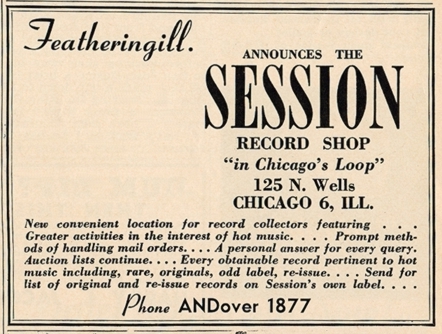
Revision note:We've corrected an error in the personnel of the Four Tons of Rhythm; our thanks to Marv Goldberg for catching it. With new information in hand about Dike-Polzin, a company in Pasadena, California that did metal parts for The Bishop Presses, located in South Pasadena, we've updated our listings on Sessions that were pressed in 1946 and 1947.
We strongly recommend Patrice Hickox's site, Session Sounds, to everyone who is interested in Phil Featheringill and Session Records.

Session was a small label that catered to specialist record buyers. During the label's active period, its co-owners were said in publicity releases to be W. P. "Phil" Featheringill and David W. Bell. Some questions remain as to who controlled what, but Featheringill was definitely the more visible of the two during the label's lifetime.
The label ran in conjunction with the Session Record Shop, operated by Phil Featheringill and his wife Evie at 125 North Wells Street in Chicago. The store's specialty, as advertised in the September 1945 Chicago telephone book, was "Original & Re-release Hot Jazz Records." Shop and label both opened for business on November 20, 1943, according to coverage in Down Beat. In his column "The Hot Box" (December 1, 1943, p. 13), George Hoefer, Jr. noted that the shop "will deal exclusively with hot jazz recordings with equal emphasis on the current crop from such sources as the Commodore, Jazz Man, etc. and the rare out of print classics."
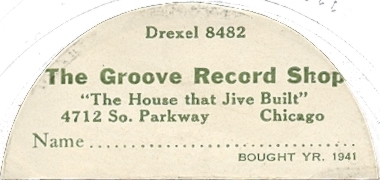
As Hoefer noted, Phil Featheringill previously worked at The Groove Record Shop at 4712 South Parkway on the South Side, where he had been running regular auctions of out-of-print jazz records.
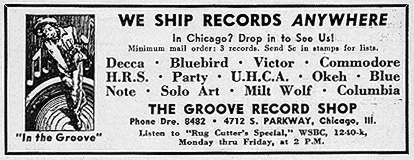
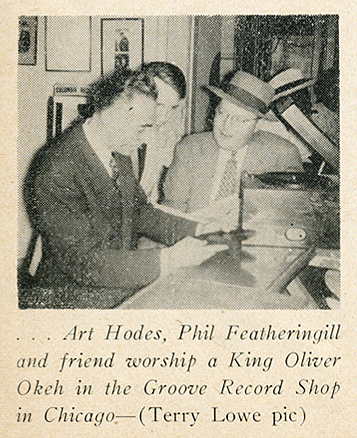
Although the label announced its intention of making "original" recordings when it was launched, Session's first releases were reissues. The targets for reissue were records made in Chicago or by artists with Chicago associations in the first half of the 1920s. (See the Appendix for complete details on the reissues.) By this point in history, many 78s from this period had been long out of print and were becoming increasingly difficult for collectors to find. More substantial reissue programs had already been mounted in the late 1930s by United Jazz Clubs of America and the Hot Record Society. The major labels (at this date, these were Columbia, RCA Victor, and Decca) had also begun reissuing jazz classics whose rights they controlled. However the recording ban of August 1, 1942 stopped new instrumental recording at the majors and the wartime shortage of shellac discouraged reissue activity as well. As an extreme specialist operation, Session focused on the product of tiny Chicago-based companies like Autograph and Rialto, which had put out important material by King Oliver and Jelly Roll Morton during the acoustic era; a ragtime piano solo by Ezra Howlett Shelton was put to use as a flip side for a Jelly Roll Morton solo that originally appeared with a coupling of no jazz interest. (One more Morton 78 reissue derived from Autograph was delayed until 1946, when it appeared on Reissue 8.) These Autograph/Rialto originals were so obscure that some were not listed in Delaunay's Hot Discographybefore Session reissued them.
The company also put out three 78s of material that had been recorded for the larger Gennett label; the artists were two groups led by Bix Beiderbecke and the Stomp Six, a combo that featured Muggsy Spanier as lead cornetist. The first three Session reissue 78s (and possibly others done before Featheringill moved his record company to California in 1946) were actually pressed by Gennett. While Gennett had quit making commercial recordings a decade earlier, the parent firm, the Starr Piano Company of Richmond, Indiana, and its pressing plant were still functioning in the 1940s.
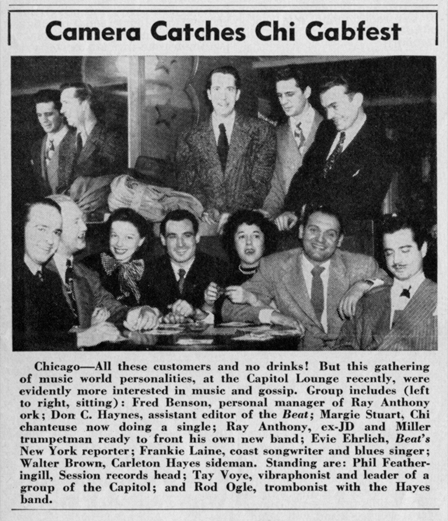
Phil Featheringill began recording new material in the fall of 1943, when he took portable equipment to a house party where ragtime pianist Alonzo Yancey was playing. He went to work in earnest recording new material in December 1943, laying down over 30 blues piano sides with Alonzo's more famous brother Jimmy and Cripple Clarence Lofton, plus an extremely obscure figure named Jesse Young.
In fact, the career of the label divides into two distinct periods. Nearly half of the total sides recorded by Session came from the piano marathon of December 1943. A peek at our discographical listings will quickly show how reissue interest has centered on the piano records. Since 1953, these have been kept in near-continuous circulation by labels that cater to fans of boogie-woogie and blues piano.
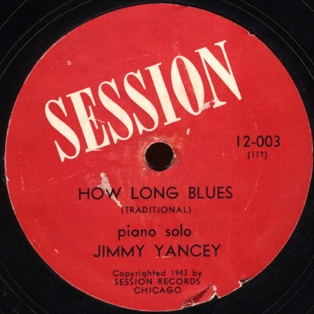
A second wave of recording began February 1944. Now the focus was on jazz combos, some strictly traditional (Richard M. Jones' Jazzmen, Punch Miller and His Southside Stompers, Art Hodes' Trio), some playing fairly advanced Swing (Trummy Young, Ben Webster, Pete Brown, John Levy and Jimmy Jones), some a little harder to categorize (J. C. Higginbotham). The combo recording activities spread out over 8 months, winding down in September 1944. These sides have drawn far less reissue interest: two of the Pete Browns waited over 50 years for a reappearance, and some of the other Swing sides have never been reissued at all.
Phil Featheringill relocated to the West Coast in the summer of 1946, taking the record company's operations with him. Then the Session Record Shop closed down in the Fall of 1946. Featheringill re-pressed many of the Sessions and made them available from a mail-order house and a record distributor that he operated in the Los Angeles area, but this final burst of activity ended in the Fall of 1947.
While most of Chicago's small indies concentrated on local musicians, Session reached out to such nationally known acts as Ben Webster and Sid Catlett to augment its stable of home-grown and locally working artists. The Yanceys and Cripple Clarence Lofton were Chicago residents, as were Richard M. Jones and Punch Miller. Though Art Hodes was a longtime resident of Chicago, and Mezz Mezzrow was a native, neither was based there when Session recorded them. Some of the Swing players were established musicians with national reputations who happened to be working gigs in Chicago: Pete Brown, Trummy Young, and J. C. Higginbotham (the last of whom was working with Henry "Red Allen" at a two-year engagement in a Loop club). A group variously billed as the Chicago Jazzmen or the Session Six included local Swing players (Jesse Miller, Eddie Johnson, and Nat Jones) who were not name artists. Jimmy Jones and John Levy, who participated on that date and later recorded as a duet, were local musicians on their way to national prominence with Stuff Smith's trio. In addition, one trad session (Art Hodes / Mezz Mezzrow) and one Swing session (Ben Webster / Sid Catlett) were conducted in New York City.
Because Session recorded jazz musicians with national prominence and Phil Featheringill, who was the Chicago correspondent for Metronome and was tight with traditional jazz advocate George Hoefer, Jr. at Down Beat, was plugged into the jazz journalism of the day, the company's offerings got unusual attention from the jazz press. We are, after all, talking about an outfit with low pressing runs, limited distribution, and high retail prices for some of its product.
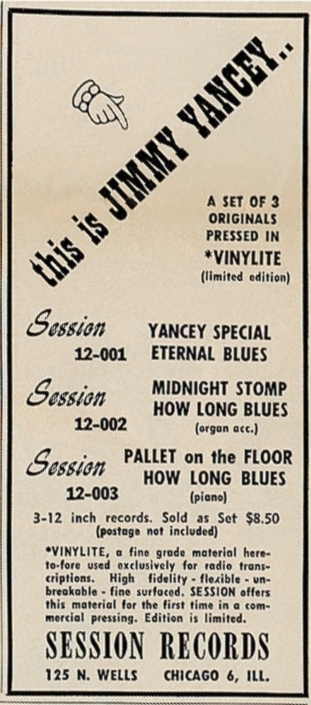
The label was so small that for nearly three years its address was the Session Record Shop (replaced, after the shop closed, by the address of the mail-order operation that Featheringill operated in the Los Angeles area). As for the matter of price, the 3-disk set This Is Jimmy Yancey (Session Set 1), which consisted of the first three Jimmy Yancey 12-inch releases on Vinylite, went for $8.50. This was a substantial sum in 1944, roughly what a classical maven had to cough up for an entire Beethoven symphony on 78s. (The company's subsequent retreat to conventional pressings brought its retail prices in line with what the competition was charging.) Moreover, the acrimony between the Moldy Figs and the Moderns was going full tilt when Session began doing combo recordings. On the Modernist side, Metronome's record reviews, which were written by Barry Ulanov and Leonard Feather, vented their fervid dislike of traditional jazz: they faulted the Session combo records for sound quality, musical interest, or both. Meanwhile Down Beat, where George Hoefer, Jr., played a prominent role, worked hard to promote Session's products. Smaller publications for old-jazz enthusiasts and record collectors also gave Session 78s a positive reception.
An unusual feature of Session's efforts was its reliance on 12-inch 78s, which took up half of the company's new releases. 12-inch records offered the advantage of longer playing times (all the way to 5 minutes, as opposed to the 3 or 3 1/2 minutes on the standard 10-inch record). But they were more expensive, and the industry reserved them mostly for classical recordings. According to Geoffrey Wheeler, in his 1999 book Jazz by Mail, distributors and retailers disliked 12-inch records because they broke more easily. A few other small jazz labels were putting out 12-inch records at the time: Commodore, HRS, General, Black & White, Comet, and Blue Note (in its early days). Session went so far as to press the first run of 12-001 through 12-003 on Vinylite. This put them in the forefront technologically, required no scarce shellac, and cut significantly down on breakage—but jacked up the cost. For their subsequent 12-inch offerings (including later pressings of the first three), Session reverted to conventional shellac and ground limestone, which they used throughout for their 10-inch releases. By going back to shellac they reduced their pressing costs, but reintroduced the breakage issue. A couple of other indie labels with jazz interests, American Music and Black & White, would soon have the same experience of releasing 12-inch 78s on Vinylite, finding it too expensive to sustain, and reverting to shellac, with the expected negative reactions from many jazz record stores.
The first six numbers in the Session matrix series (100 through 105) were used for Reissue Session 1 through 3 (see our Reissue listing at the end of the page).
The first new sides recorded for the label, though not the first to be released, were the work of Alonzo Yancey, a ragtime pianist and brother of the much more famous Jimmy. These have been listed as studio recordings in the past. We know that Phil Featheringill recorded Alonzo at a house party, at some point in the fall of 1943, and we strongly suspect that at least one of Alonzo's sides as issued on Session came from that source; what we don't know is whether some of the others were recorded in the studio in December 1943, as discographies have previously stated.
We also don't know the actual order of recording for the solo piano items on Session, so we will be grouping them by artist, starting with Alonzo Yancey.
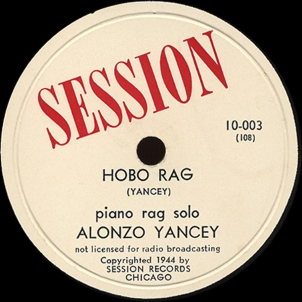
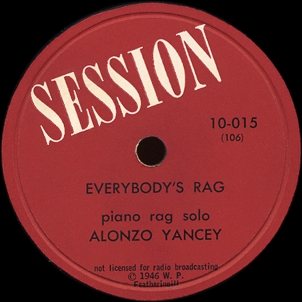
Alonzo Yancey (p).
Chicago, prob. Fall 1943
| PF-31-B (60-B) | Unknown Rag | Wayhi L93 [cassette], Document BDCD 6045 | |
| PF-32-A (61) | Ecstatic Rag | Wayhi L93 [cassette], Document BDCD 6045 | |
| PF-32-B (62) | Everybody's Rag | Wayhi L93 [cassette], Document BDCD 6045 | |
| WC-106 DP | Everybody's Rag | Session 10-015, Pax LP6012, Jazztone J-1023, Guilde du Jazz J.1023, Origin of Jazz Library OJL16, Biograph BLP-12047, Gannet GEN5138, Storyville SLP238, Document DOCD-5043 | |
| WC-107 DP | Twelfth St. Rag | Session 10-015, Gannet GEN5138, Storyville SLP238, Document DOCD-5043 | |
| WC-108 DP | Hobo Rag (Yancey) | Session 10-003, Pax LP6012, Gannet GEN5138, Storyville SLP238, Document DOCD-5043 | |
| 109 | Ecstatic Rag | unissued | |
| 110 | Ecstatic Rag | unissued | |
| WC-124 DP | Ecstatic Rag (Yancey) | Session 10-003, Gannet GEN5138, Storyville SLP239, Document DOCD-5043 |
In his column "The Hot Box" (Down Beat, August 1, 1944, p. 11), George Hoefer, Jr., had an announcement to make:
Also scheduled for release soon are some interesting piano rags by Jimmy Yancey's brother, Alonzo, who passed away a month after cutting the sides. Alonzo had never played other than at house parties prior to April 1944. He composed many rags and stomps, one of which he made at this session. This number is Ecstatic Rag, which will be paired with Hobo Rag on Session 10-003. The two other sides, Everybody's Rag and 12th St. Rag will be assigned a number later. Alonzo Yancey was a friend and companion at house parties with Clarence Lofton and his brother, Jimmy.
We don't buy the April 1944 date that Hoefer mentions. According to Godrich, Dixon, and Rye (4th edition), Alonzo was recorded at a party in the fall of 1943. And the PF prefixes to the numbers that were written on the original acetates of the first three items on this entry point to someone we know. In 1990, the masters of these party recordings of Alonzo Yancey were auctioned off, and three of the sides were finally issued, first on a Wayhi cassette in 1993, then later that year on a Document CD. There may be additional unissued acetates from this source.
Other discographies have given December 1943 as the recording date for matrix numbers 106-110 and 124. But complicating matters is the fact that matrix 107, "Hobo Rag," is incomplete (just 1:45 as issued, and missing its opening). Were some of the items that ended up with 100-series Session matrix numbers also recorded on portable equipment at a house party?
Session 10-003 and 10-015 were 10-inch 78s. 10-003 is copyrighted 1944 and presumably exists in an earlier version with an F prefix to the matrix numbers. However, the copies we are aware of were manufactured in 1946 by The Bishop Presses, of South Pasadena, California; the matrix numbers are incised, but have the WC prefix (for West Coast). After the matrix number there is a monogram, which we can't reproduce accurately in our listing, of a D with a P stuck in it. This, we recently learned, stood for Dike-Polzin Record Processing, 221 South Arroyo Parkway, Pasadena, California. Dike-Polzin (by 1950 it had changed its name to Deeco) did the masters and mothers for most of the records that Bishop pressed.
Session 10-015 was released in early 1947 (it was first advertised in the March 1947 issue of the Record Changer, and reviewed by John Lucas in May). Known copies have a red label, a 1946 copyright date, and incised matrix numbers in the shellac with a WC prefix and another Dike-Polzin monogram after the nubmer. Pressings were by Bishop, a company in South Pasadena, California that Featheringill acquired a financial interest in. He used The Bishop Presses, which opened in April 1946, for all of his later Session pressings. Bishop regularly handled releases for Jump, a small Southern California-based company, and from December 1946 through June 1950 pressed most of John Steiner's S D, Dublin's, and Paramount releases.
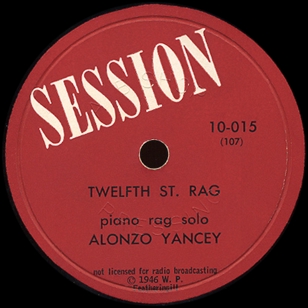
Pax LP6012 was a 10-inch LP titled An Evening with the Yanceys: Jimmy, Mama & Alonzo ; its contents were listed in the Pax Jazz LP catalog of May 1954, where it was scheduled for issue in September 1954--but it never made it.
Jazztone J-1023, a straight repackaging of Pax LP6012 in the 10-inch format, was released in 1957; its counterpart Guilde du Jazz J.1023 was a French LP titled Une soirée avec les Yancey (Jimmy-Mama-Alonzo).
Gannet GEN5138 was a British LP that John Holley issued c. 1975. Titled Jimmy Yancey and Alonzo Yancey Volume 3; it was filled out with Jimmy Yancey's sides for Victor and Bluebird (1939-1940) and Vocalion (1940), as well as two home recordings from 1940.
Storyville SLP238 was a Danish LP titled The Yancey-Lofton Sessions, Volume 1. Storyville SLP239 appeared under the title The Yancey-Lofton Sessions, Vol. 2; both also include material by Jimmy Yancey and Cripple Clarence Lofton.
Biograph BLP12047 was a various-artists collection titled Black and White Ragtime 1921-1939 [sic].
Document DOCD-5043 was released in the 1990s under the title Jimmy Yancey Volume 3: 1943-1950; it is obvious who is responsible for the remainder of the tracks! Document BDCD 6045, Piano Discoveries (1928-1943), released in 1993, was a collection of piano recordings which also included a track by Ezra Howlett Shelton (see the entry Reissue 3, in the Appendix) and items by Jimmy Yancey and Cripple Clarence Lofton (not of Session origin).
Görgen Antonsson (http://sunsite.kth.se/feastlib/mrf/yinyue/pw/YANALO.HTM) claims that Origin of Jazz Library OJL-16, which came out in 1968, actually contained 108 "Hobo Rag" and mistitled it as 106 "Everybody's Rag"—this needs to be checked. According to Antonsson's listing for the label at http://sunsite.kth.se/feastlib/mrf/yinyue/pw/ORIGI.HTM, OJL-16 was titled Ragged Piano Classics and included one track each by Robert Cooper, Herve Duerson, Will Ezell, Blind Leroy Garnett, Sugar Underwood, and Alonzo Yancey, as well as additional performances by "white or jazz artists."
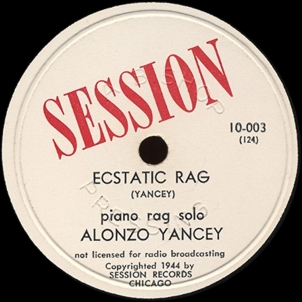
Matrix numbers 111 and 112 remain unaccounted for. Jimmy Yancey's contributions begin with number 113 (see below). So 111 and 112 could have been intended for the mysterious Session 10-004, by one Jesse Young.
Jesse Young (p)
Chicago, 1943
| 111? | Flyin' Santa Fe | Session 10-004[?] | |
| 112? | Skipper | Session 10-004[?] |
Jesse Young was a blues pianist, as one might expect from the titles, and from the focus of the label's recording activities in 1943. But all we have on his sides is a solitary entry in the Esquire Jazz Book for 1945. Leonard Feather's "Discography of the Year" for 1944 (p. 137 in the aforesaid Esquire tome) lists Session 10-004 and identifies the sides as "piano solos." The promised release never materialized.
No Jesse Young is listed in Godrich, Dixon, and Rye, or in any other blues discography. The only other trace we have found of him is a composer credit for "Greyhound Bus," a number recorded by Washboard Sam on August 5, 1940, and issued on Bluebird B-8540-B. (See our Buster Bennett page for details; the pianist on the session was Blind John Davis.) Nor have any of the reissues of the Session piano records included Young's sides. All we can do is hope that the masters have been preserved and that they will see issue one day.
The most extensively documented pianist on the early Session recordings, Jimmy Yancey, was born in Chicago on February 20, 1898. From ages 6 to 17 he worked as a singer and tap dancer in vaudeville. Starting around 1919 he played piano in public and played professional baseball in the Negro Leagues. In 1925 he took what would be his day job for the rest of his life, as a groundskeeper for the Chicago White Sox at Comiskey Park. Jimmy Yancey made his first records in Chicago for Solo Art in 1939. He recorded in Chicago for Victor (also 1939), Vocalion (1940), and Bluebird (1940), and cut two tracks in his home in 1940 that were released years later. In 1941, he suffered a stroke that imposed some limitations on his left-hand technique. He cut several records at private parties in Chicago in the fall of 1943 before undertaking his marathon date for Session.
Again not knowing the order in which they were recorded, we have grouped all of Jimmy Yancey's December 1943 sides together. As far as we know, all were studio recordings. The missing matrix numbers belong to one side by his brother Alonzo (124; already listed in Sess1) and to six by Cripple Clarence Lofton (125 through 130; see Sess4 for these).
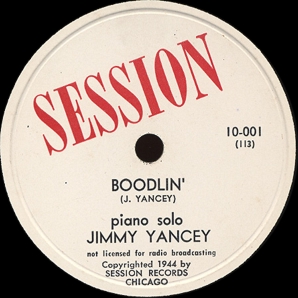
Jimmy Yancey (voc -1; p -2; harmonium -3); Estella "Mama" Yancey (voc -4).
prob. Chicago Recording Company, Chicago, December 1943
| WC-113-C | Boodlin' (Yancey) -2 | Session 10-001, Vogue LDE166, Jazztone J-1224, Vogue V2365 [78], Vogue EPV-1203, Jazz Selection JSLP 50.019, Folkways FJ2082, Gannet GEN5136, Jazz Anthology 30JA5212, Storyville SLP238, Document DOCD-5042 | |
| 114 | Yancey's Mixture -2 | Pax LP6011, Jazztone J-1224, Jazztone J-1258, Jazz Selection JSLP 50.019, Vogue LDE166, Gannet GEN5136, POP SPO 17.003 [EP], Jazz Anthology 30JA5212, Storyville SLP238, Document DOCD-5042 | |
| 115 [J143*] |
Death Letter Blues -1, 2 | Jump JL-7*, Pax LP6011, Jazztone J-1224, Jazz Selection JSLP 50.019, Vogue LDE166, Gannet GEN5136, Jazz Anthology 30JA5212, Storyville SLP238, Document DOCD-5042 | |
| 116 [J142*] |
Sweet Patootie -2 | Jump JL-7*, Pax LP6011, Jazztone J-1224, Vogue EPV-1203, Vogue LDE166, Jazz Selection JSLP 50.019, Gannet GEN5136, Jazz Anthology 30JA5212, Storyville SLP238, Document DOCD-5042 | |
| 117-A; WC-117 B-1811x [J141*?] |
How Long Blues (trad.) -2 | Session 12-003, Folkways FP 55, Jump JL-7* [?], Folkways FJ2802, Folkways FE4602, Gannet GEN5137, Storyville SLP238, Document DOCD-5042 | |
| ? [J141*?] |
How Long Blues (trad.) -2 | Session 12-003, Jump JL-7* [?]. Pax LP6012 [?], Jazztone J-1023, Guilde du Jazz J.1023, Oldie Blues [Nl] OL 2802, Document DOCD-5042 | |
| 118 | The Rocks (Yancey) -2 | Pax LP6011 [LP], Vogue LDE 166 [LP], Vogue V2365 [78], Jazztone J-1224, Vogue EPV-1203, Jazz Selection JSLP 50.019, POP SPO 17.053 [EP], Gannet GEN5136, Jazz Anthology 30JA5212, Storyville SLP238, Document DOCD-5042 | |
| WC-119 | Jimmy's Rocks (Yancey) -2 | Session 10-001, Oldie Blues [Nl] OL 2802, Gannet GEN5137, Document DOCD-5042 | |
| 120; WC-120 B-1812 | How Long Blues (trad.) -3, 4 | Session 12-002, Pax LP6007, Oldie Blues [Nl] OL 2802, Gannett GEN5137, Roots EPL001, Storyville SLP239, Document DOCD-5042 | |
| 121? | Mama's Blues -2, 4 | Session 12-004 [?], Pax LP6007 [?] | |
| 122? | Rough and Ready | Session 12-004 [?], Pax LP6007 [?] | |
| 123 | White Sox Stomp -2 | Jazztone J-1023, Guilde du Jazz [Fr] J-1023, Oldie Blues [Nl] OL 2802, Gannet GEN5137, Storyville SLP239, Blues Encore CD52031, Document DOCD-5043 | |
| CRC-131; WC-131 B-1813 | Eternal Blues (Yancey) -2 | Session 12-001, Pax LP6012, Jazztone J-1023, Guilde du Jazz J.1023, Oldie Blues [Nl] OL 2802, Gannet GEN5137, Storyville SLP239, Blues Encore CD52031, Document DOCD-5043 | |
| 132 | I Received a Letter -2 | Pax LP6012, Jazztone J-1023, Guilde du Jazz J.1023, Oldie Blues [Nl] OL 2802, Gannet GEN5137, Storyville SLP238, Document DOCD-5043 | |
| (133); WC-133 B-1814 [J139*] |
Yancey Special (Yancey) -2 | Session 12-001, Jump JL-7*, Pax LP6012, Jazztone J-1023, Guilde du Jazz J.1023, Oldie Blues OL 2802, Gannet GEN5137, Joker SM 4081, Joker SM 9416, Storyville SLP239, Jazmine JSMCD2538, Document DOCD-5043 | |
| CRC-134; WC-134 B-1815x | Midnight Stomp (Yancey) -2 | Session 12-002, Pax LP6011, Vogue LDE 166, Jazztone J-1224, Gannet GEN5136, Jazz Selection JSLP50.019, Jazz Anthology 30JA5212, Storyville SLP238, Jazmine JSMCD2538, Document DOCD-5043 | |
| (135); WC-135 B-1816 | Pallet on the Floor (trad.) -2, 4 | Session 12-003, Pax LP6012, Jazztone J-1023, Guilde du Jazz J.1023, Oldie Blues [Nl] OL 2802, Gannet GEN5137, Storyville SLP239, Blues Encore CD52031, Document DOCD-5043 | |
| WC-136 DP [J140*] |
Shave 'em Dry (Yancey) -2 | Session 10-005, Jump JL-7*, Pax LP6012, Jazztone J-1023, Guilde du Jazz J.1023, Oldie Blues [Nl] OL 2802, Gannet GEN5136, Storyville SLP239, Document DOCD-5043 | |
| WC-137 DP | At the Window (Yancey) -2 | Session 10-005, Pax LP6011, Jazztone J1224, Vogue EPV-1203, Vogue LDE166, Jazz Selection JSLP 50.019, Gannet GEN5136, Jazz Anthology 30JA5212, Storyville SLP239, Document DOCD-5043 | |
| 138 [J138*] |
Make Me a Pallet on the Floor (trad.) | Jump JL-7*, Pax LP6007, Gannet GEN5137, Storyville SLP239, Oldie Blues [Nl] OL 2802, Roots EPL001, Document DOCD-5043 | |
| 139 |
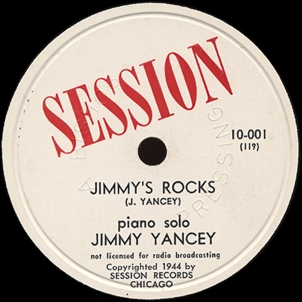
There are two versions of the solo piano "How Long Blues." It took nearly 20 years before anyone called attention to this fact in print: in his review of Gannet GEN 5137 and Oldie Blues OL 2802 in Blues Unlimited (August 1974, p. 22), Mike Rowe noted that the LPs used different versions of "How Long." But Rowe, not knowing Session 12-003, called the Gannet version (which had been dubbed from a Session 78) an alternate take, and referred to the version released on a Jazztone LP (and taken up by Oldie Blues) as the original. In fact, 117-A (which appears as WC-117 on later pressings) is the only take of 117 known to to exist; it times in at just under 4 minutes. Discographies have further mixed things up with still a third version of "How Long" (recorded as a vocal with harmonium accompaniment, matrix 120). The 117 version appears on Document CD 5042 as track 16.
The original matrix number for the second solo version of "How Long" (first issued on Jazztone J-1023 and its French counterpart Guilde du Jazz J.1023) remains unknown. This version fades in and, because of the extra-slow tempo, runs 4 1/2 minutes. The Storyville and Document issues give the matrix number as 117, but this was an incorrect surmise (besides which, the Storyville compilers didn't know the real 117); each different version of a tune on the blues piano sessions was given a different matrix number. On Document 5042, this version appears as track 15.
Session 10-001 was a 10-inch release; it appeared in 1944. Known copies of 10-001 have white labels and stamped matrix numbers with a WC prefix, pressed by Bishop.
Session 12-001, 12-002, and 12-003 were 12-inch 78 rpm releases; they were initially packaged as Session Set 1, This Is Jimmy Yancey, pressed on Vinylite and sold for the stiff price of $8.50. The red labels on the Vinylite copies have an odd appearance that results from being glued over other red labels that were then sanded down. The apparent source of the trouble was inadequate preparation of the area around the center hole before the labels were glued on. (Pressing on Vinylite really was a brand-new procedure at the time.) The labels carry a 1943 copyright date, and the matrix numbers are incised in the vinyl.
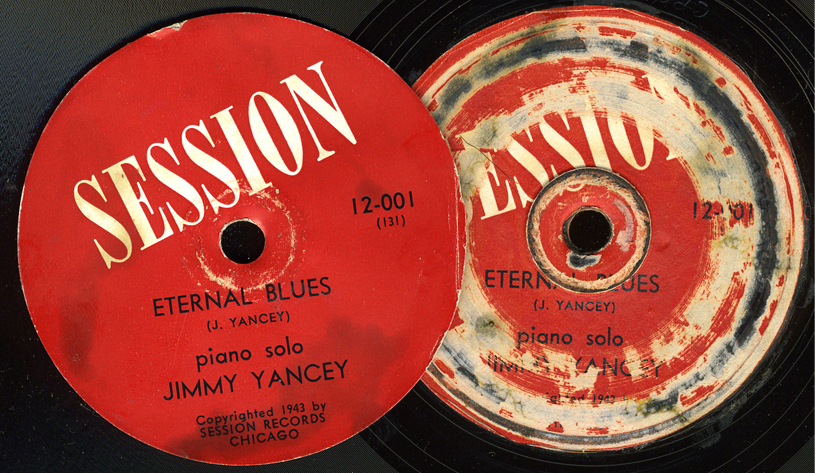
Most extant copies of the Vinylite pressings are made of black vinyl (which has grayed somewhat with age). However, Mama Yancey remembered in a 1964 interview with Barbara Dane and Pete Welding that she and Jimmy had made "LPs" (i.e., 12-inch records) for Session, and that they were pressed on red Vinylite. (Our thanks to Jane Bowers for her transcription of part of the interview.) And sure enough, a red Vinylite copy of 12-001 has turned up at an auction.
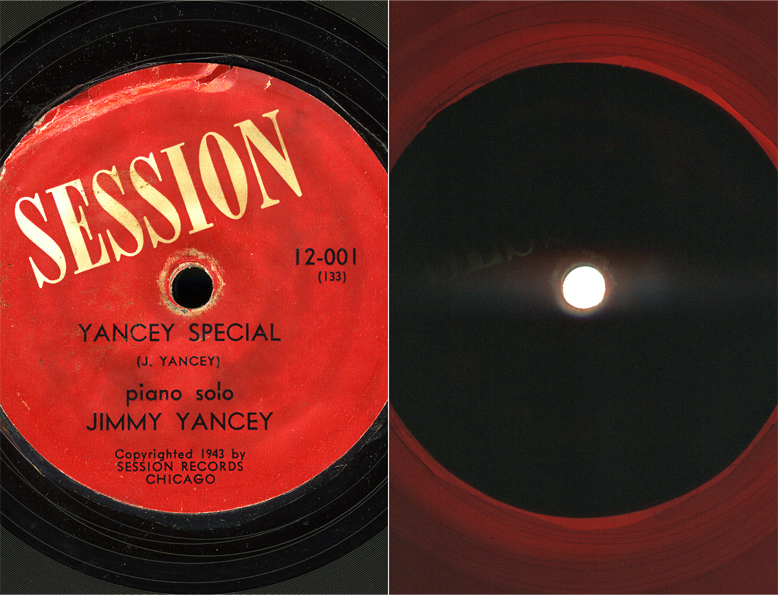
The later pressings were done on shellac with neatly applied white labels, a 1944 copyright date, and WC prefixes on stamped matrix numbers. The later pressings of 12-001 through 003 were sold separately.
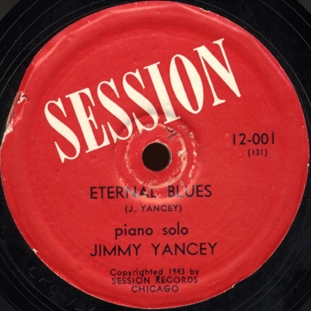
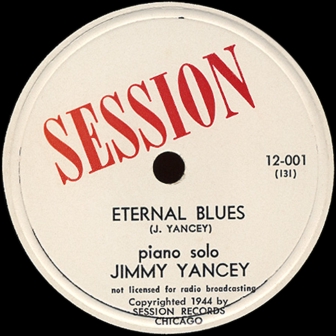
The Vinylite pressings of Session 12-001 carry CRC-131 incised in the vinyl on one side—and nothing on the other (though 133 can be seen on the label). CRC stands for Chicago Recording Company, a commercial studio that was active in the mid-1940s. CRC also did mastering; it handled some of S D's releases that were pressed in 1944. The shellac pressings have numbers with WC prefixes stamped in the shellac, and B series stamper numbers incised.
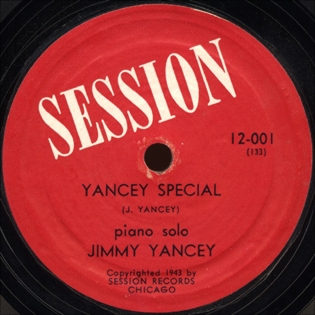
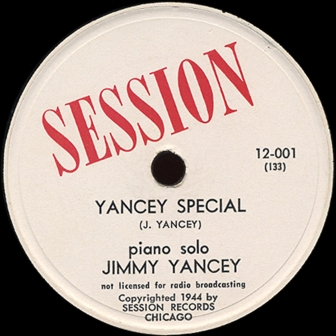
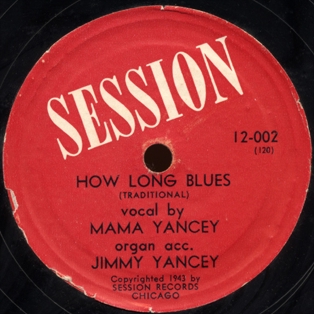
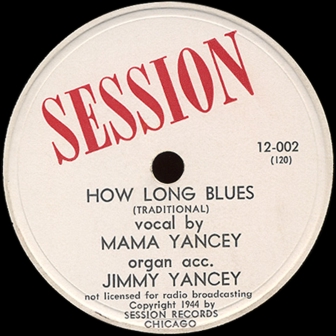
The Vinylite pressings of Session 12-002, which are from 1943-1944, carry CRC-134 incised in the vinyl on the "Midnight Stomp" side (120 on the other). The shellac pressings, from 1946 or later, use WC prefixes for the stamped matrix numbers; there is also a stamper number in the B 1800 series (from Bishop) on each side.
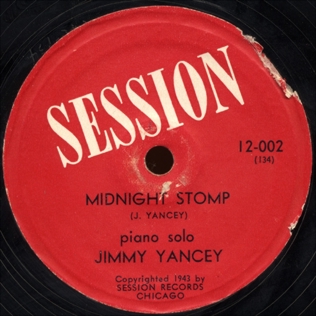
"Midnight Stomp" as issued on Session 12-002 consisted of 18 blues choruses. Jimmy Yancey normally did not repeat himself during an improvisation, but chorus 15 and 16 on the original performance are virtually identical. On the Pax LP and the Gannet LP the track is unedited. On Jazztone J-1224, one of the repetitive choruses (either 15 or 16) has been cut; the same is the case on the Document CD.
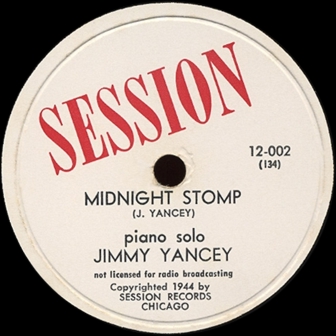

On the original Vinylite pressings of Session 12-003, the matrix numbers are incised in the vinyl, with no prefixes (in fact the 135 side has no matrix number in the vinyl at all, though there is one on the label.) Later pressings are on shellac, carry white labels and 1944 copyright dates, and have stamped matrix numbers with the WC prefix and incised stamper numbers with the B prefix for Bishop.
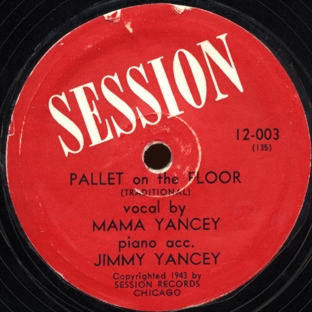
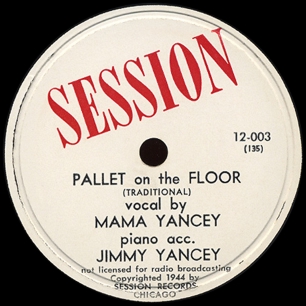
On Febuary 15, 1944, George Hoefer Jr.'s column "The Hot Box" announced that the first three Sessions were in the offing, and would be sold as a set for $8.50. "In addition to catching the real Yancey [the Featheringills] discovered that Mama Yancey (Jimmy's wife) can sing very fine blues, and she sings on two of the sides."
On May 15, 1944, Down Beat followed up with an ecstatic review (p. 8) of "Session Set 1," This Is Jimmy Yancey. The review was by "Jax" (John Lucas, a trad jazz proponent who was located in Chicago and was obviously in close touch with Featheringill). As Jax opined, "the Featheringills have caught the true spirit of Jimmy Yancey and his wonderful wife Estella. Yancey Special gives Jimmy plenty of opportunity to exercise his famous boogie abilities at a medium tempo, and he comes through with a performance that completely outclasses the fine rendition by Meade Lux Lewis." The 5 remaining performances received comparably glowing commentary. And Lucas had no complaints about the extra expense: "Pressed in Vinylite, the first commercial use of this flexible and unbreakable material, this limited edition possesses amazing fidelity." In Down Beat for January 1, 1945, Session 12-001, "Eternal Blues" b/w "Yancey Special" was one of 3 Session releases to make "Mix"'s top 10 list for "Piano Discs" ("Best Hot Discs of 1944," p. 11).
Another laudatory review of the set was contributed by Master Sergeant George Avakian. Duly noting the steep price, Avakian wrote "I think I'd cheerfully cough up the major portion of a sawbuck just for Eternal Blues and Make Me a Pallet on the Floor..." (The Jazz Record, September 1944, p. 3). But Avakian was already a fervent admirer of Vinylite (which was being used, noncommercially, for V-Disks produced for the entertainment of the armed forces). He had once owned a Benny Goodman 78 experimentally manufactured out of the substance; he would entertain guests by dropping it on the floor and slamming it against the wall before playing it. As for the music on the set, "It is, quite distinctly, the feline's mustaches. Jimmy's piano should be known to all jazz fans, and for the first time we hear his wife, Estella, known as Mama—and a worthy successor to the great traditional blues singers she is" (p. 13). Avakian prefers her contribution on Pallet on the Floor to her singing on the vocal version of How Long ("Jimmy plays organ on this side (apparently of the home-grown, foot-pedal variety)"). Out of the instrumental sides, Avakian singles out Eternal Blues. Of the instrumental How Long he says, "very slow, deliberate, and delicately simple." He describes Yancey Special as "the weak side of the date, which is merely praise for the rest of the session. You know the tune from the Meade Lux recording; it's also a standard testing piece for all your neighbors who try to learn boogie woogie on their pianos."
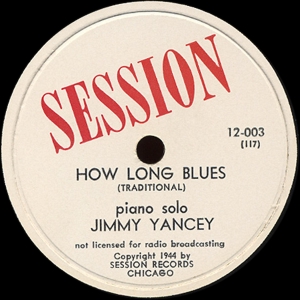
Before Session 12-001 through 12-003 were re-pressed on shellac, there was an extended period, at least 2 years, of unavailability (the press runs for the Vinylite versions had to be minuscule).
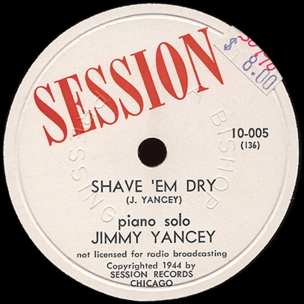
Session 10-005 was a 10-inch 78 made in extremely limited quantities. We know of just three copies: one in Konrad Nowakowski's collection, one in the SONIC database, and one in the collection of the late John Steiner (who played it in 1999 on a BBC Radio 3 program that presented a portrait of Jimmy Yancey).
Session 10-005 was first advertised in a Records, Inc. ad in the Record Changer for March 1947 and reviewed in the May issue. The copy in our hands was pressed by Bishop (in 1947) and has WC prefixes in the shellac; as with the copies of Session 10-003 that we have seen, the matrix numbers are stamped instead of incised and are followed by the Dike-Polzin monogram. Was there an earlier pressing of 10-005 with the F prefix? Collectors, what say you?
In his article on Jimmy Yancey's recordings for Record Research, Walter C. Allen declared that "only a few copies were pressed gratis for friends" (Volume 2, no. 1 issue 7, February 1956, p. 5). His source was George Hoefer's liner notes for Pax LP 6011, which were apparently referring to a 1944 test pressing.
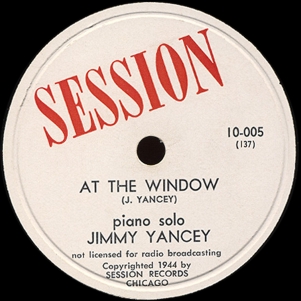
Session 12-004 was announced but apparently never issued; hence the matrix numbers are not known. However, George Hoefer, Jr. mentioned 12-004 again in the discography attached to his 1951 Down Beat obituary article for Jimmy Yancey, so he must have heard a test pressing! At least one side of 12-004 was scheduled for release on Pax LP6007 (maybe there was a jinx in operation, for that LP never came out either). There are suggestive gaps in the matrix series at 121 and 122 and again at 139.
The first reissue of an Session material was a 10-inch LP on Folkways FP 55, a various-artists compilation called Jazz, Vol. 2: The Blues. Though copyrighted 1950, it probably came out in 1951 (it was reviewed in the Record Changer, June 1951 issue, pp. 15 and 18). The use of the Session material may have been unauthorized; another LP in the same series led to a lawsuit by Marili Ertegun of Jazz Man and Rudi Blesh of Circle, who charged that Folkways was bootlegging their material. Folkways FJ 2802 was a straight reissue of FP 55, and we assume that FE4602 did likewise, though it would be nice to be able to confirm this. The Folkways issues incorrectly identify "How Long" as coming from Session 12-002 (that would be matrix 120), instead of Session 12-003 (matrix 117).
Next came Jump JL-7, a 10-inch LP of Jimmy Yancey material put out by Ed Kocher and Clive Acker, whose record sales and distribution enterprises Phil Featheringill worked for after his move to the West Coast in 1946. It was released in 1953. (Tom Lord's Jazz Discography, Volume 26, manages to mention one of the tracks that appeared on Jump JL7: 138, "Make Me a Pallet on the Floor.")
Pax LP6011, said to be available in the Pax catalog for May 1954, but actually issued in December of that year, was titled Yancey's Mixture: 24 Minutes with Jimmy Yancey. Pax LP 6012, intended to be issued in September, was to be titled An Evening with the Yanceys: Jimmy, Mama, & Alonzo. Pax LP6007, Jimmy & Mama Yancey, was announced for release in July or August of 1954, but never materialized either.
Vogue L.D.E. 166, a 10-inch LP titled Jazz Immortals No. 2 Jimmy Yancey-Piano Solo was listed among the latest releases in Jazz Journal for February 1956.
Vogue EPV-1203 was a British EP that consisted of the B side of Pax LP6011, in a different order; it was released in March 1957 and reviewed in Jazz Journal's July 1957 issue (p. 20).
Jazz Selection J.S.L.P. 50.019 Jazz Immortals no. 1: Yancey's Mixture is a straight reissue of Pax LP6011 done by French Vogue; the master numbers on each side are the same as on the Pax.
POP SPO 17.053, abc du jazz - i: Piano Traditionnel is an EP made by French Vogue, perhaps at a later date. The other 3 titles are from other sources. "The Rocks" cames out correct on the cover but is misspelled "the roks" on the label.
Jazztone J-1224, Pioneers of Boogie Woogie: Jimmy Yancey and Cripple Clarence Lofton was a 12-inch LP that incorporated material from two issued 10-inch Pax LPs, 6005 and 6011. The Yancey side is identical to Pax LP6011, tracks in the same order as they appeared on Side A then Side B—except that "Midnight Stomp" has been discreetly edited (see above). The Jazztone LP appeared in March 1956, according to Geoffrey Wheeler, Jazz by Mail (published 1999, pp. 112-113). Jazztone J-1258 was 12-inch LP sampler that included one Jimmy Yancey track from J-1224; it was released in March 1947, according to Geoffrey Wheeler's book Jazz by Mail (1999, p. 144). Jazztone J-1023 was a 10-inch LP issued in 1957; its French counterpart, Guilde du Jazz J.1023, was titled Une Soiréee avec les Yancey (Jimmy-Mama-Alonzo). J-1023 was unusual in the Jazztone line in that it was issued only in Europe, not in the USA.
Oldie Blues OL 2802, The Immortal Jimmy Yancey 1898-1951, released in the Netherlands 1974, was a reissue of Jazztone J-1023 with two 1940 tracks by Jimmy Yancey added and one track by Alonzo Yancey deleted.
Gannet GEN5136 and 5137 were British LPs released in 1974 as Jimmy Yancey/Cripple Clarence Lofton Volume 1 and Volume 2.
Jazz Anthology 30JA5212 belonged to a big series of cheap reissue LPs put out by the French company Musidisc in the mid to late 1970s. We are assuming that it drew from the previous releases on Jazztone and Vogue but it would be nice to have confirmation on that.
Storyville SLP238 was a Danish release titled The Yancey-Lofton Sessions, Vol. 1. On SLP238, the track titled "Sweet Patootie" is actually "Boodlin'," which therefore appears twice on the LP (oops!). Storyville SLP239 was a Danish release, The Yancey-Lofton Sessions, Vol. 2.
Jazzmine JSMCD2538 is a British various artists compilation on CD titled Boogie Woogie Volume 1—Piano Soloists.
Document DOCD 5042 is an Austrian CD released in 1991 under the title Jimmy Yancey Volume 2. The continuation on DOCD 5043 goes as Jimmy Yancey Volume 3: 1943-1950; this CD follows Jazztone J-1224 in using the edited version of 134, "Midnight Stomp."
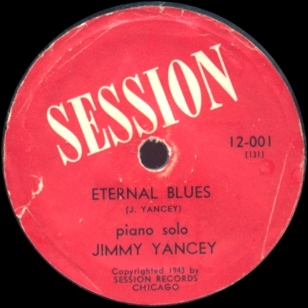
After making these sides for Session, Jimmy Yancey, though musically active, was off the recording scene for several years. George Hoefer Jr.'s column "The Hot Box" (Down Beat, January 28, 1946, p. 17) noted that "Gene Keasler, Chicago Times sportswriter, recently did column Boogie Woogie On The Diamond featuring Jimmy Yancey who helps take care of the White Sox ball park. Jimmy's record of Pallet On The Floor is called Pile It on the Floor. Also announces Jimmy and Mama are working on a new tune to be called Weekly Blues. Jimmy Yancey performed at Carnegie Hall with Mama Yancey in 1948, and worked regularly at the Bee Hive in Chicago from 1948 through 1950, when it featured traditional jazz instead of the bebop for which it became known later. In December 1950, Jimmy Yancey made a session at the Myron Bachman studio; it was sold to John Steiner and appeared on a 10-inch LP on his revival of the Paramount label. Steiner liked the material so much he pretended to have recorded it. In 1951 Jimmy Yancey recorded an album's worth of material for Atlantic (his last studio session) and participated in several private sessions that were later released on Document. Jimmy Yancey died in Chicago on September 17, 1951. (For biographical information see J. Bradford Robinson and Barry Kernfeld, "Jimmy Yancey," in B. Kernfeld (Ed)., New Grove Dictionary of Jazz (2nd edition, Volume 3), pp. 1002-1003 (New York: Grove's Dictionaries, 2002).
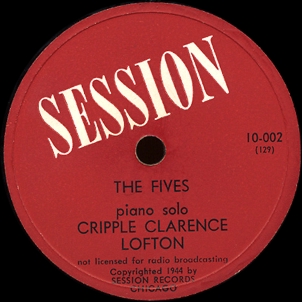
The other major contributor in the early going, Cripple Clarence Lofton, was born on March 28, 1887 in Kingsport, Tennessee. His physical impairment, a birth defect to one leg that gave him a pronounced limp, wasn't serious enough to prevent him either from tap dancing or from playing the piano while standing up. A leading exponent of boogie woogie, he developed a high energy act during years spent working tent shows. In the 1930s, he ran his own club, the Big Apple, in Chicago. Lofton began recording in Chicago in 1935 (sessions for Vocalion and the American Record Company, as well as one side for Bluebird as "Albert Clemens"). In 1938 or 1939, he appeared on a private recording session whose contents were issued on LP in the 1960s and 1970s by Swaggie, Yazoo, and Mauros. In 1939 Lofton recorded for the Chicago-based Solo Art label, which also recorded Jimmy Yancey; these were reissued on Riverside in 1954, and subsequently by London, BYG, and others. He retired in the late 1940s after boogie-woogie went out of fashion. Cripple Clarence Lofton died of a stroke in Chicago on January 9, 1957.
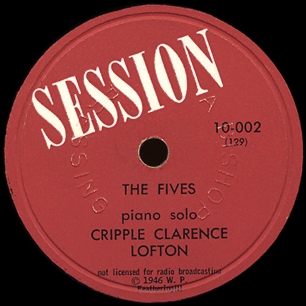
Cripple Clarence Lofton (voc, p); unidentified (perc -1).
prob. Chicago Recording Company, Chicago, December 1943
| 125 | Streamline Train -1 | Pax LP6005, Jazztone J-1224, Vogue EPV-1209, Vogue LDE 122, Jazz Selection JSLP50.021, Gannet GEN5136, Jazz Anthology 30JA5212, Storyville SLP238, Jazmine JSMCD2538, Document BDCD6007 | |
| 126 | I Don't Know-II | Pax LP6005, Vogue L.D.E. 122, Vogue EPV-1209, Jazz Selection JSLP 50.021, Gannet GEN5136, Jazz Anthology 30JA5212, Storyville SLP238, Document BDCD6007 | |
| WC-127 | Policy Blues (Lofton) [CCL voc] | Session 10-014, Pax LP6005, Jazztone J-1224, Vogue LDE122, Jazz Selection JSLP 50.021, Gannet GEN5136, Jazz Anthology 30JA5212, Saydisc Matchbox SDR 146, Storyville SLP238, Document BDCD6007 | |
| WC-128 | I Don't Know (Lofton) [CCL voc] | Session 10-014, Pax LP6005, Vogue LDE122, Jazztone J-1224, Jazz Selection JSLP 50.021, Gannet GEN5136, Jazz Anthology 30JA5212, Saydisc Matchbox SDR 146, Storyville SLP238, Document BDCD6007 | |
| F-129; WC-129 | The Fives | Session 10-002, Pax LP6005, Jazztone J-1224, Vogue EPV-1209, Vogue LDE 122, Jazz Selection JSLP 50.021, Gannet GEN5136, Jazz Anthology 30JA5212, POP SPO 17.003 [EP], Storyville SLP238, Document BDCD6007 | |
| F-130; WC-130 | South End Boogie (Lofton) | Session 10-002, Pax LP6005, Jazztone J-1224, Vogue EPV-1209, Vogue LDE 122, Jazz Selection JSLP 50.021, Gannet GEN5136, Jazz Anthology 30JA5212, Storyville SLP238, Document BDCD6007 | |
| F-140; WC-140 DP | In de Mornin' (Lofton) | Session 10-006, Pax LP6005, Jazztone J-1224, Vogue LDE 122, Jazz Selection LP50.021, Gannet GEN5136, Jazz Anthology 30JA5212, Joker SM 4081, Joker SM 9416, Storyville SLP239, Document BDCD6007 | |
| F-141; WC-141 DP | Early Blues (Lofton) | Session 10-006, Pax LP6005, Jazztone J-1224, Vogue LDE 122, Jazz Selection JSLP 50.021, Gannet GEN5136, Jazz Anthology 30JA5212, Storyville SLP239, Document BDCD6007 | |
| F-142 | I Don't Know (Lofton) | Session 12-005, Gannet GEN5137, Storyville SLP239, Document BDCD6007 | |
| F-143 | Streamlined Train (Lofton) | Session 12-005, Gannet GEN5137, Storyville SLP239, Document BDCD6007 |
The original releases were the 12-inch 78—Session 12-005—and three 10-inch 78s: Session 10-002, 10-006, and 10-014.
Session 12-005 was released in the summer of 1944. Pressed on shellac, the copies that we know of carry red labels; the incised matrix numbers show the F prefix.
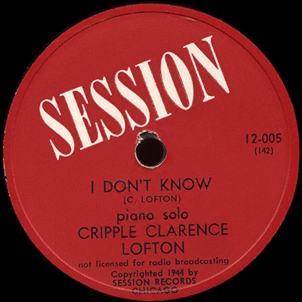
Session 12-005 was reviewed by John Lucas in Down Beat on August 1, 1944 (p. 8). "Both of Lofton's numbers have already appeared some years ago [1939] on Dan Qualey's Solo Art, but here the Featheringills give the eccentric boogie veteran plenty of elbow-room and plenty of leeway. Streamline is good, but I Don't Know is great. It's bizarre and hypnotic, in fact, at times smacking more than faintly of the oriental and specifically of the Balinese. In a word it's weird, friends! If you like these, which I hope and expect you will, you really ought to catch Lofton in person. The man is mad!"
On January 1, 1945, the reviewer who went as "Mix" listed Session 12-005 as one of the 10 best "piano discs" of 1944 ("Best Hot Discs of 1944, Down Beat, p. 11). No fewer than 3 Session releases made the list, along with 4 by James P. Johnson on Blue Note and two by Oro "Tut" Soper on rival Chicago-based indie Steiner-Davis.
We have not encountered a postwar re-pressing of Session 12-005. Such a thing would have a WC prefix on the matrix number or some other indicator of involvement from The Bishop Presses.
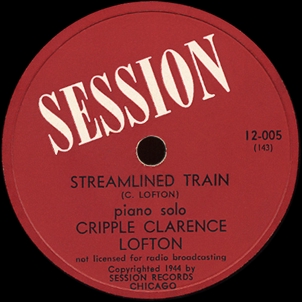
Session 10-002 was issued in 1944 with a red label and matrix numbers with an F prefix stamped in the wax (in italics). The 1946 re-pressings also have a red label, but now the matrix number has a WC prefix and is stamped in the wax, and the pressings are by Bishop with the center die it often employed ("A Bishop Pressing" is embossed on the label on one side).
A review of the re-pressing appeared in the Record Changer for February 1946 (p. 15). Noting that Lofton's piece called The Fives had nothing in common with the Jimmy Yancey number with the same title, the reviewer says
It is a great piano piece whatever the question of names. Lofton really has only two themes. He plays the first theme about six times, varying it the last two. After the fourth we hear the breaks that Romeo Nelson uses on Head Rag Hop. Listen to Lofton's right hand on this break...
South End Boogie is slow. The introduction barely establishes the tempo but the old foot stomping away can be heard on the record. The piece proper starts with Lofton's left hand deep in the bass. The rhythm of this piece is heavy and musically sonorous. His inventions are very musical and in the medium of the greatest piano jazz. ... This whole boogie blues has a majesty in its slew-foot pace that few boogie pieces have.
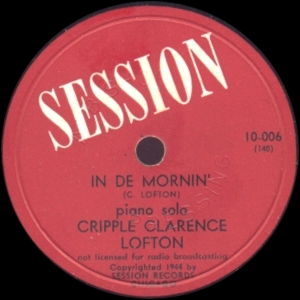
The exact release date for Session 10-006 is not known, but the label reads "Copyrighted [sic] 1944." There are earlier copies with a white label and the F prefix in the shellac; the matrix numbers are incised. Later copies have a red label and the WC prefix that is characteristic of Bishop pressings; the matrix numbers are incised (as on the copies of 10-003 and 10-005 that we are familiar with) and there is a Dike-Polzin monogram after the number.
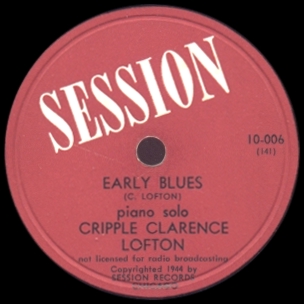
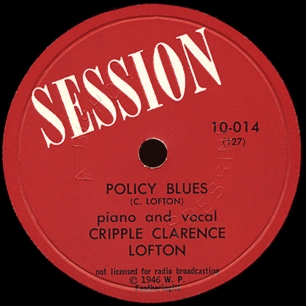
Session 10-014 was released in the first quarter of 1946; it was mentioned in the "Current Records" list in the Record Changer for May 1946. It is known only in copies pressed by Bishop with a red label, a 1946 copyright date, and stamped matrix numbers with the WC- prefix.
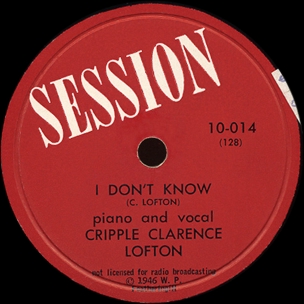
Pax LP6005, a 10-inch LP titled Cripple Clarence Lofton, was released in May 1954. George Hulme's Pax listing (in the Matrix 58, 22-26) errs in giving "Deep End Boogie" as the original title of 130; on Session 10-002 it was already titled "South End Boogie." The Pax LP gives the title "I Don't Know-I" to the vocal version (matrix 128).
Vogue L.D.E. 122 is a 10-inch LP released in 1955 under the title Jazz Immortals No. 1: Cripple Clarence Lofton. It is a straight reissue of the Pax LP, using the same master numbers for each side. Probably in 1957, Vogue put out the 4-track EP EPV-1209. On this one, matrix 126 appears "I Don't Know," then on the cover its matrix number is wrongly given as 142!
Jazztone J-1224, a 12-inch LP incorporating material from the 10-inch Pax LPs 6005 and 6011, appeared in March 1956 under the title Pioneers of Boogie Woogie: Jimmy Yancey and Cripple Clarence Lofton.
Jazz Selection J.S.L.P. 50.021 is a 10-inch LP produced by Vogue; like L.D.E. 122 it is a straight reissue of Pax LP 6005 down to the matrix numbers on each side. 128 is titled "I Don't Know, vocal by Clarence Lofton."
Gannet GEN5136 was a British LP released in 1974 as Jimmy Yancey/Cripple Clarence Lofton Volume 1. It gives the title of 126, "I Don't Know-II" as "I Don't Know." Gannet GEN5137 was also issued in 1974, as Jimmy Yancey/Cripple Clarence Lofton Volume 2.
Jazmine JSMCD2538, a British CD titled Boogie Woogie Volume 1: Piano Soloists, also includes "I Don't Know"--either matrix 126 with the vocal or 128 without.
Document BDCD 6007, Cripple Clarence Lofton Vol. 2: 1939-1943 is an Austrian CD released in the mid-1990s. On it "I Don't Know-II" is listed as "I Don't Know No. 2."
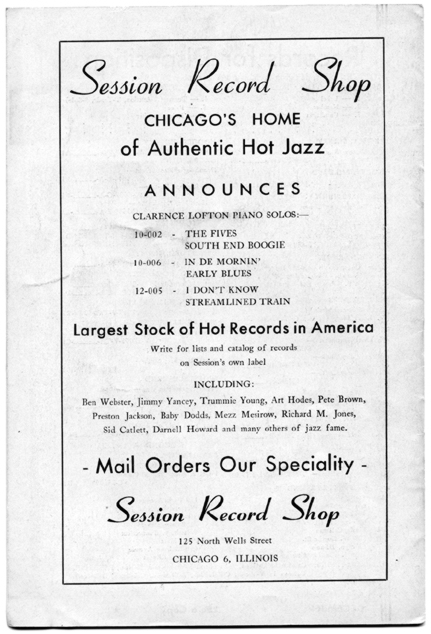
Around the same time that Session was cutting its first new recordings, Phil Featheringill was involved in producing the Spring 1944 issue (Volume 2, Number 1) of Jazz Quarterly, which focused on New Orleans jazz. He contributed several pen and ink drawings to the issue.
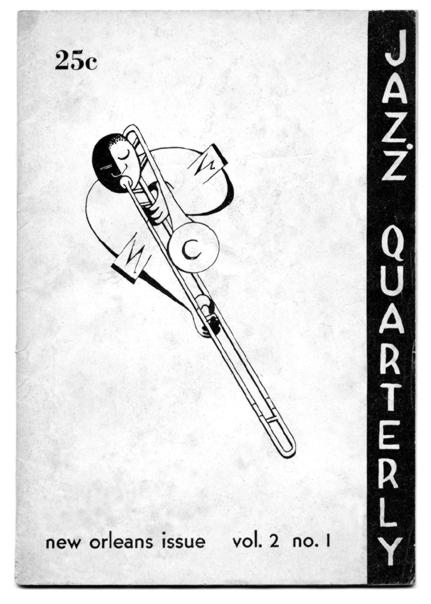
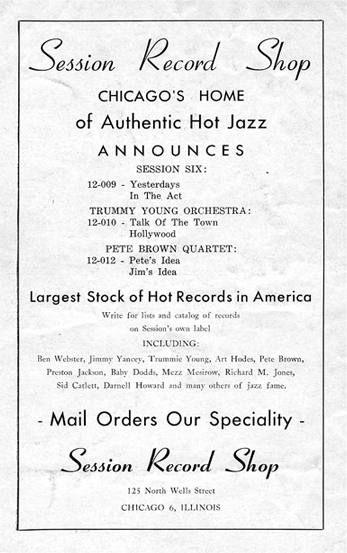
The first combo to appear on Session, led by Trummy Young, was in town playing the Capitol Lounge when Featheringill approached the leader about recording his unit.
James Osborne "Trummy" Young was born in Savannah, Georgia, on January 12, 1912. He began working professionally on the trombone in 1928, in Washington, DC. In 1933 he joined the Earl Hines Orchestra (where he did not solo often on recordings). In 1937 he went with the Jimmie Lunceford band, where he hit full maturity as a soloist. Young also sang comic numbers with the Lunceford band.
After leaving Lunceford in March 1943, Young toured with Charlie Barnet for a little while, then picked up some work with other leaders. Toward the end of the year he started own combo. A profile in Metronome (February 1944, p. 12) states: "In a matter of a few weeks, Trummy has built a six-piece combo that is a 'must' for expert ears. The few less initiated patrons also listen, entranced, to the trombonist-singer's well-planned arrangements." The profile indicates that Young recruited Leo Williams, Harry Curtis, John Malachi, and Tommy Potter (he seems to have added Eddie Byrd when he left Louis Jordan's combo). Accompanying the article were three photos of the group taken at the Capitol Lounge in Chicago. One feature sharply dates the profile: Young had visions of expanding his combo to a big band when the war ended. Wasn't going to happen, but it seems nobody realized it then.
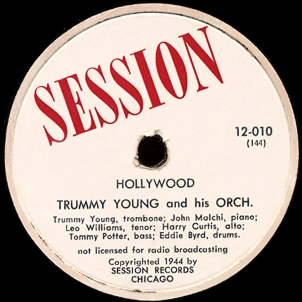
James "Trummy" Young (tb; voc -1); Harry Curtis (as); Leo Williams (ts); John Malachi (p); Tommy Potter (b); Eddie Byrd (d).
Chicago, February 7, 1944
| F-144 | Hollywood (no composer listed) | Session 12-010, Pax LP6008, Classics [Fr] 1037 [CD] | |
| F-145 | Talk of the Town (Cohn) -1 | Session 12-010, Classics [Fr] 1037 [CD] | |
| 146 | The Man I Love (part 1) | Session 12-011 [?], Pax LP6008 | |
| 147 | The Man I Love (part 2) | Session 12-011 [?], Pax LP6008 |
Session 12-010 was released in December 1944 and reviewed in Down Beat on December 15, 1944 (p. 8); it was categorized as "Swing." In Metronome's profile of Trummy Young's combo (February 1944) and its "Exclusive Jazz Discography" (June 1944, p. 25) as well as in the Down Beat review, the saxophonists are identified as Harry Curtis on alto and Leo Williams on tenor (all three sources misspell Malachi's last name, as Session also did in its publicity for the single).
Session promptly ran an advertisement announcing the availability of 12-010 (along with 12-009 by the Session Six and 12-012 and Pete Brown) in the January-February 1945 issue of The Jazz Session.
In his Jazz Discography, Volume 26, Lord puts Leo Parker on alto sax and Harry Curtis on tenor sax, but provides no reason for this alteration. But then he also manages to leave off Session 12-010! Curtis and Williams are mentioned in contemporary accounts of Young's group, and on the labels of Session 12-010. A listen to "Hollywood" reveals an alto sax solo by a somewhat lachrymose Swing player who bears no resemblance to Leo Parker whatsoever.
Known copies of Session 12-010 have a white label and matrix numbers incised in the shellac using the F prefix. Like the contemporary media treatments, the label on 12-010 misspells Malachi as "Malchi."
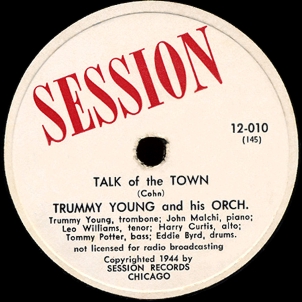
Session 12-011 was announced during the lifetime of the company and has been listed in discographies; it was meant to contain the two-part treatment of "The Man I Love." We have no evidence that it was actually released, however, and it has consequently eluded the recent reissue program on Classics.
Reviewing 12-010 for Down Beat, John Lucas liked the leader's work but had little praise for the rest of the band: "Hollywood opens with a three-man ensemble sounding like thirty. Harry Curtis plays a solo reminiscent of Tab Smith's alto, then Trummie [sic] comes on for two that are full of slurs and smears, even for a trombone! John Malchi's [sic] piano is fast if nothing else, and Leo Williams' tenor is pretty sad. The closing ensemble is light and buoyant, very amazing for such a set-up! Talk is all Trummie, and the girls will go all out for this side! Young's vocal is certainly cute, for Trummie's either knocked out or groggy. His trombone is just like his singing here, the most typical thing Trummie's ever recorded. Harry Curtis plays an alto as if he's practicing but far from perfect, while Malchi's piano is pleasant if nothing more. Williams' tenor work during the closing ensembles is far better than his work on the reverse."
Otherwise, Session 12-010 got little attention from reviewers. In the Jazzette for March-April 1945 it got onto the "Also Recommended" list (p. 26, no comments about highlights or quality of performance).
Trummy Young's sides for Session were his very first as a leader, and carry the distinction of being done with a working group. Heard today, the Session 12-010 sides have the most "modern" sound of any of the combo recordings Young made during this period, and we are fortunate that this group got to record. While the saxophonists in the group remained obscure, John Malachi would join Billy Eckstine's bop-oriented big band, then settle in Chicago, and Tommy Potter went on to play in several high-profile bop quintets, most notably Charlie Parker's.
Young would continue to record as a leader through 1946, on such labels as Signature (unfortunately not released), Duke (not the famous Houston-based indie of the 1950s), G. I. (unlike the others, a big band session), and HRS. Although the later sessions featured great work by top-flight musicians such as Don Byas on tenor sax and Buck Clayton on trumpet, they were all done with pick-up groups. In 1946 and 1947 Young also participated in the Jazz at the Philharmonic tours, on top of which he led two V-Disc sessions.
In 1947 Young settled in Hawaii, which took him out of circulation as far as most jazz fans were concerned. However, he was back in front of the public from 1952 through 1963 as a member of Louis Armstrong's All Stars, where he developed a highly personal approach to traditional jazz trombone. On leaving Armstrong he returned to Hawaii, though he made occasional tours with different leaders. His later recordings as a leader were few: a session in France for Ducretet Thomson (in 1955), and two LPs done in Hawaii for a company called Flair (1975 and 1979). Trummy Young died in San Jose, California on September 10, 1984.
Pax LP6008 was announced in May 1954 as a 10-inch LP titled Higgy & Trummy; supposedly scheduled for release in June, it was to consist of 3 Trummy Young tracks on Side B and 3 J. C. Higginbotham tracks on Side A. It never came out.
Classics 1037 is a French CD, released in 1998, titled Trummy Young 1944-1946. It includes all of his available 1940s sides as a leader, and is the first actual reissue of Session 12-010. The compilers complained that Session 12-011 (and, of course, Pax LP6008) could not be found.
The company's next session took place in New York City. We are not sure how this was put together--did Featheringill supervise the recording in person? In any event, it featured two musicians with ties to Chicago and its traditional jazz scene.
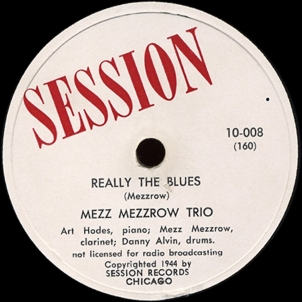
Milton Mesirow, known for most of his adult life as Mezz Mezzrow, was born in Chicago on November 9, 1899. He began recording in Chicago in 1928, departing for New York later that same year. Opinions of Mezz's clarinet playing continue to be divided: admirers maintain that he was a folk artist, detractors that he was merely out of his league technically. He definitely could play the blues and for many years he was able to hang out—and record—with the greats. (He frequently supported himself by selling "mezzrolls"—a now extinct synonym for marijuana cigarettes—to his fellow musicians, and gained further notoriety with his autobiography Really the Blues, which was published in 1946.) He began recording as a leader in 1933 and was fairly active in the studios until the late 1950s. From 1945 through 1947 operated his own record company, King Jazz, in New York; it is best known today for the string of sessions that Mezzrow recorded featuring Sidney Bechet. The very last King Jazz session was actually made in Chicago in December 1947, while Bechet was working Jazz Ltd. (the club's owners did not want him to leave town during his engagement). It should be noted that Mezzrow generally holds up his end musically on the King Jazz sides. In 1951, Mezzrow moved to France, where he continued to record until 1959, also appearing in two movies. After several years of limited playing activity, he died in Paris on August 5, 1972.
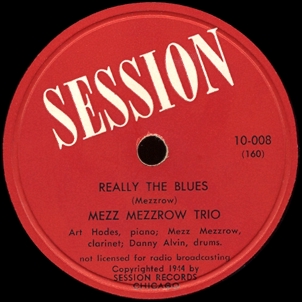
Arthur W. Hodes was born in Nikoliev, Ukraine, probably on November 14, 1904 (there has always been some fuzziness about the year). Fleeing from persecution, his family moved to New York City when he was 6 months old and on to Chicago when he was 6 years old. His first gig was playing solo at the Rainbow Gardens in 1920. By the time he made his first recording with Wingy Mannone in 1928, he had become fully committed to jazz. He remained based in Chicago until 1938, when he moved to New York, working with Joe Marsala and Mezz Mezzrow and then starting his own band in 1941. Hodes first recorded under his own name in 1939 for Solo Art, followed by a session in 1940 for Jazz Record (his own company). Thereafter he recorded for Signature, Jazz Record, Black & White, and Decca. Around two weeks after this session he would begin cutting for Blue Note (no fewer than 4 sessions in 1944, followed by 5 in 1945). From 1943 to 1947, he also edited The Jazz Record, a magazine that promoted traditional jazz. In 1950 he moved back to Chicago, where among other engagements he led the band at Jazz Ltd. in 1953, 1956, and 1957. He continued to record prolifically, while writing extensively about jazz and hosting two TV series. He made his last record in 1989 and had to quit playing after suffering a stroke in 1991. Art Hodes died in Harvey, Illinois, on March 4, 1993.
Mezz Mezzrow (cl); Art Hodes (p); Danny Alvin (d).
New York City, March 5, 1944
| F-160; WC-160-F | Really the Blues (Mezzrow)^ | Session 10-008, Pax LP6013, Classics [Fr] 1074 [CD] | |
| F-161; WC-161-F | Milk for Mezz (Mezzrow)^ | Session 10-008, Pax LP6013, Classics [Fr] 1074 [CD] | |
| F-162; WC-162-F | Feather's Lament (Hodes) | Session 10-007, Pax LP6013, Classics [Fr] 1074 [CD] | |
| F-163; WC-163-F | Mezzin' Around (Hodes) | Session 10-007, Pax LP6013, Classics [Fr] 1074 [CD] |
The session was listed in Metronome (June 1944, p. 25) although no recording date was given.
"Feather's Lament" is a title assigned in cutting irony. At the time Hodes, an ardent "moldy fig," had become Barry Ulanov and Leonard Feather's chief punching bag in the pages of Metronome. In January 1944, the magazine reviewed a Hodes release on another label: "these sound like an amateur band entertaining in an air shelter. Us, we'll face the bombs." In February 1944, Barry Ulanov declared that a live appearance by Hodes: "presented a pathetic set... tinkly, faltering, vapid... really a chore." In March either Feather or Ulanov really went beyond the pale in a review of another Hodes release: "Many of Art Hodes' personal friends... have taken us severely to task for our unkind review... But oddly enough, none of them tried to offer any musical defense. Even men who have worked with him follow the line of reasoning which runs: 'Don't be hard on the guy. We know he can't play, but he's sincere and he means well and he's kind to children.' Alas, we can't let this influence us..." That was the month that Hodes sued Metronome "for heavy damages," according to a brief item that appeared in the April 1944 issue.
Given his bellicose role in the Moldy Fig vs. Modernist brouhaha, Feather didn't much care for Session Records either, despite Phil Featheringill's contributions to Metronome. In his roundup of independent jazz labels, "Waxing Furious," published in the June 1944 issue of Metronome (p. 18), Feather had this to say: "Session Records are in the hands of Phil Featheringill. Reissues and a very few special recordings, pressed in very limited quantities at high prices (three Jimmy Yanceys, as a set, set you back $8.50)." By contrast, trad-friendly reviewers went out of their way to assure potential buyers that 12-inch pressings on Vinylite were worth the extra expense.
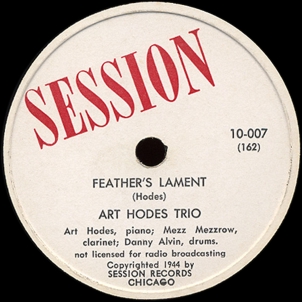
Session 10-007 was issued in September 1944, followed by 10-008 around November. 10-007 was released under Hodes' name, while 10-008 came out under Mezz Mezzrow's name.
Early pressings of Session 10-007 have white labels and the F prefix on incised matrix numbers; later pressings also have white labels but show the WC prefix on stamped matrix numbers, and an F suffix. One side on the later pressing shows the embossed Bishop logo. On the "Mezzin' Around" side, an error is corrected by striking through a digit, so the matrix number reads WC-1603-F.
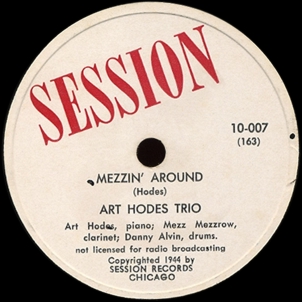
Earlier pressings of Session 10-008 carry white labels and the F prefix on the incised matrix numbers; later pressings have red labels, the Bishop pressing log embossed on one side, and a WC prefix to stamped numbers (there is also an F suffix—was this just carried over from the first pressing, or did it have some other meaning?). Both editions show a 1944 copyright date on the labels.
This session is covered in Lord's Jazz Discography, Volumes 9 and 14. Lord hypercorrects "Mezzin' Around" to "Messin'" in his listing under Art Hodes' name. But then Lord lists 162 and 163 a second time under Mezzrow's name, this time "Mezzin'" it up properly. (In his Mezzrow entry, Lord throws in a track titled "My Daddy Rocks Me," which was not recorded for Session.)
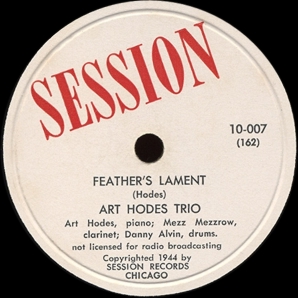
Session 10-007, which listed Hodes as the leader, got a review from John Lucas in Down Beat on October 1, 1944 (p. 8). "On the Session sides Art manages to tear Mezzrow away from his book long enough to cut the best clarinet he has ever waxed. The first is all Mezz's, a clarinet jump that builds up and up dynamically so that the tension increases all the way. Hodes' piano and Alvin's drums furnish excellent accompaniment, but this number is really strictly for Mezz. The reverse is a slow blues, played with deep feeling by all three, especially by Art."
Metronome predictably jumped all over 10-007 in its October 1944 issue (pp. 25-26). The reviewer gave "Feather's Lament" a C- and "Mezzin' Around" a D. "The Hodes Trio, Art, Mezz Mezzrow, and Danny Alvin, is consecrated to the purpose of presenting Mezz's feeble clarinet. On the Lament you have a lot of uncertain groping on the clarinet and a really lamentable cut-off in the middle of the last chorus, as if the engineer said stop and they just stopped. Some phrases reminiscent of Mezzrow's Apologies begin a curious exhibition of clarinet on Mezzin' Around, some frantic one-note bleating, some stiff fingering, unrelieved by any sounds we could find pleasant."
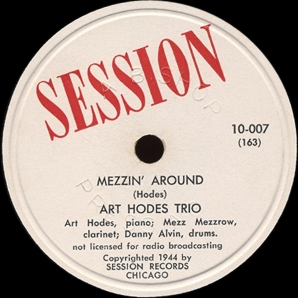
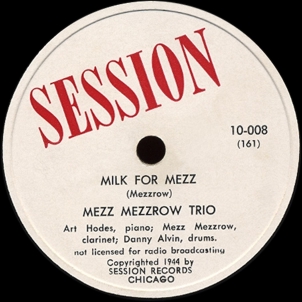
Session 10-008 got the typical exultant Lucas treatment in Down Beat on December 15, 1944 (p. 8). Categorized as a "hot jazz" offering, it was praised by the reviewer who noted the ardent blues playing on both sides: "Here are shades of Jimmie Noone and, say, Paul Barbarin or Zutty Singleton. These three white jazzmen have kept faith!"
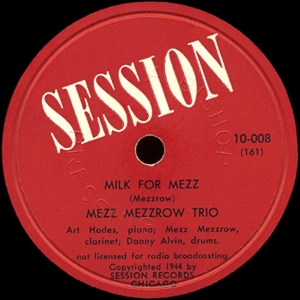
In the January 1, 1945 issue of Down Beat, the "Best Hot Discs of 1944" featured competing lists by "Jax" (whose real name was John Lucas) and "Mix." On the "Mix" list, Session 10-007 made the top 10 for "Piano Discs" (p. 11).
Pax LP6013 was titled Dixie a la Hodes and was advertised in the Record Changer, December 1954. (It had not been included in Pax's catalog of May 1954.) The four titles from this session were to appear on Side A of this 10-inch LP. It is not known what was intended for Side B, but obviously it had not been made for Session. The LP was never released.
We know of just one (!) further reissue of this material: all 4 sides from this session appeared on Classics 1074, a CD released in 1999 under the title Mezz Mezzrow 1944-45.
Session matrix numbers 148 through 153 were attached to the reissue 78s that came out in March 1944 on Reissue Session 5 through 7; see the Reissue section at the end of the page for more about these. Unfortunately Featheringill lost track of his matrix assignments two years later; he ended up reusing 154 and 155 for his final reissue effort on Reissue 8. (Because the two sessions recorded in New York City were entered into the master book later, their matrix numbers don't line up with the recording dates.)
Session continued its trad jazz efforts with 4 12-inch sides by a band led by the legendary Richard M. Jones.
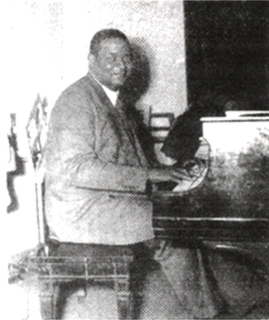 A veteran of the Chicago scene, Richard M. Jones was born in Barton, Louisiana on June 13, 1892. (His middle name has been given variously as Mariney and Myknee; in his later years he was addressed as "Myknee," pronounced like "my knee.") He worked in New Orleans as a pianist from 1908 to 1918. He arrived in Chicago in 1919, finding employment in Clarence Williams' music publishing house. He first recorded in 1923, when he did laid down two piano solos for Gennett. In 1925 and 1926 he recorded as a leader for OKeh, where he also functioned as the recording director for many blues sessions. He would become most famous, however, for supervising the sessions by Louis Armstrong's Hot Five. He also recorded a session with King Oliver's Dixie Syncopators (1926) and appeared on Willie Hightower's only session (1927). He subsequently cut three sessions for Victor (1927 and 1929), Gennett (under the pseudonym "Wally Coulter," 1927), and Paramount (1928). In 1935, Jones made three sessions in Chicago for Decca and in 1936 he cut two sides for Bluebird; in 1940 he recorded with Jimmie Noone for Decca. Preston Jackson (1902-1983; on the Chicago scene since 1917) had appeared on three of Jones' OKeh sessions in 1926. For a time he ran a record store; he also was involved in distributing OKeh records. Jones gained some renown as a songwriter; his most famous tunes were "Trouble in Mind" and "Caldonia."
A veteran of the Chicago scene, Richard M. Jones was born in Barton, Louisiana on June 13, 1892. (His middle name has been given variously as Mariney and Myknee; in his later years he was addressed as "Myknee," pronounced like "my knee.") He worked in New Orleans as a pianist from 1908 to 1918. He arrived in Chicago in 1919, finding employment in Clarence Williams' music publishing house. He first recorded in 1923, when he did laid down two piano solos for Gennett. In 1925 and 1926 he recorded as a leader for OKeh, where he also functioned as the recording director for many blues sessions. He would become most famous, however, for supervising the sessions by Louis Armstrong's Hot Five. He also recorded a session with King Oliver's Dixie Syncopators (1926) and appeared on Willie Hightower's only session (1927). He subsequently cut three sessions for Victor (1927 and 1929), Gennett (under the pseudonym "Wally Coulter," 1927), and Paramount (1928). In 1935, Jones made three sessions in Chicago for Decca and in 1936 he cut two sides for Bluebird; in 1940 he recorded with Jimmie Noone for Decca. Preston Jackson (1902-1983; on the Chicago scene since 1917) had appeared on three of Jones' OKeh sessions in 1926. For a time he ran a record store; he also was involved in distributing OKeh records. Jones gained some renown as a songwriter; his most famous tunes were "Trouble in Mind" and "Caldonia."
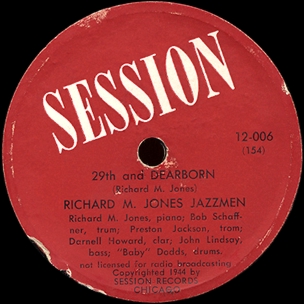
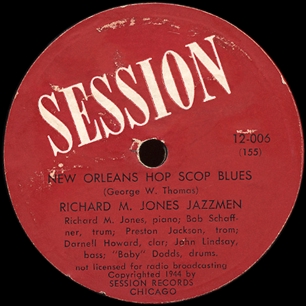
Richard M. Jones (p); Bob Shoffner (tp); Preston Jackson (tb); Darnell Howard (cl); John Lindsay (b); Warren "Baby" Dodds (d).
Chicago, March 23, 1944
| F-154-C | 29th and Dearborn (Jones) | Session 12-006, Pax LP6010, Folkways FJ2817, Carrousel CAR19, Gannet CJR1002 [CD], Classics [Fr] 853 [CD] | |
| 154 [alt.] | 29th and Dearborn (Jones) | Gannet CJR1002 [CD] | |
| F-155-B | New Orleans Hop Scop Blues (Thomas) | Session 12-006, Pax LP6010, Folkways FJ2817, Carrousel CAR19, Gannet CJR1002 [CD], Classics [Fr] 853 [CD] | |
| 155 [alt.] | New Orleans Hop Scop Blues (Thomas) | Gannet CJR1002 [CD] | |
| F-156-A | Jazzin' Babies Blues (Jones) | Session 12-007, Pax LP6010, Folkways FJ2817, Carrousel CAR19, Gannet CJR1002 [CD], Classics [Fr] 853 [CD] | |
| F-157-A | Canal Street Blues (Oliver-Armstrong) | Session 12-007, Pax LP6010, Folkways FJ2817, Carrousel CAR19, Gannet CJR1002 [CD], Classics [Fr] 853 [CD] |
The original releases on Session 12-006 and 12-007 were given a detailed advance review by George Hoefer, Jr. in his column "The Hot Box" (Down Beat, April 15, 1944, p. 13); about the release plans Hoefer merely said "these records should be out soon." Hoefer supplied the complete personnel, along with titles, couplings, and rundowns of the soloists on each side.
The copies of Session 12-006 and 12-007 that we have seen were are pressed on shellac; they have red labels and the F prefix in front of the matrix numbers, which are incised in the shellac. The copy of 12-006 in Konrad Nowakowski's collection actually has the red labels pasted on top of blank labels, rather like the early Vinylite editions of 12-001 through 12-003. We don't know whether other copies of 12-006 all look like this.
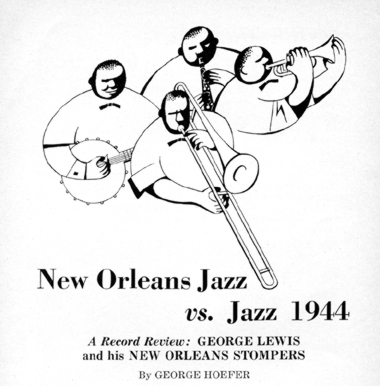
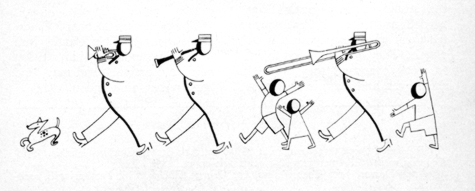
George Hoefer Jr.'s advance review in Down Beat(see above) was strongly enthusiastic. Of 12-006 Hoefer said:
The Jones opus dedicated to a south Side corner [29th & Dearborn] is played in a medium tempo with fine rhythm background. Long solos by Howard, Jackson and Shoffner. The composer of the tune that was renovated by Bob Crosby under the name Dixieland Shuffle plays a piano chorus. The N. O. Hop Scop which was written years ago by George W. Thomas is introduced by Jackson's trombone and an an ensemble chorus followed by Jackson in solo, Howard's clarinet playing reminiscently similar to his cousin Barney Bigard, a drum-piano duet with Baby riding the rimes, and Shoffner's trumpet sounding off in the Oliver Vocalion tradition. The finale of the rendition is of all things a session of close riffing by these jazz individualists.
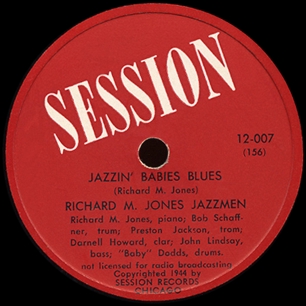
Hoefer's thoughts about Session 12-007:
[Jazzin' Babies Blues] is of course another famous Richard Jones tune which also saw service as Tin Roof Blues. Opened by Jones himself playing some of that mean sporting piano of Storyville followed by Howard in the high register, the rendition continues unabated in the best Dixieland manner. This is probably the best of the four sides. Felt throughout these records and especially in Jazzin' is the solid bass support rendered by John Lindsay, a fine musician. The last side is the Oliver-Armstrong tune [Canal Street Blues] made famous by the Creole Band Gennett record. Done in a faster tempo it showcases noteworthy solos by all the participants.
When the records were commercially released, Down Beat followed up with an official review of 12-006 and 12-007 in its issue of August 1, 1944 (p. 8). According to John Lucas, "When I heard the test pressings of these platters, less than half a day after they were waxed, I declared vehemently that they were the best examples of real New Orleans jazz ever cut. Perhaps I'm prejudiced, but I still think so. They have minor flaws of course, but such insignificant moments only serve to enhance the magnificent effects of the whole performance." Lucas reserved his highest praise for Darnell Howard's clarinet work (as good, he says, as anything by Johnny Dodds, Jimmie Noone, Omer Simeon, or Sidney Bechet...), with Preston Jackson's trombone solos just behind. He also singles out the way the drums were recorded: "Thank God, someone's finally got Baby's drums down on wax just as they sound in person!"
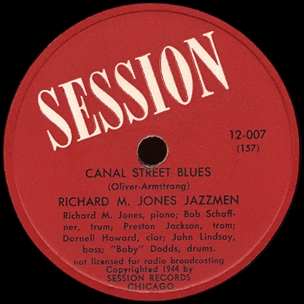
Also firmly in the trad camp, The Jazz Session put 12-006 in at number 4 on its list of the "Ten Best Recordings of 1944" (January-February 1945, p. 22). The other entries were by Wild Bill Davison's Commodores, Art Hodes' Blue Note Seven, Muggsy Spanier's Ragtimers, Miff Mole's Nicksieland Band, George Bruns' Jazz Band, Kid Ory's Creole Jazz Band, and LaVere's Chicago Loopers.
The opening comment in Hoefer's column of April 15 seems apropos here: "Hostilities between the advocates of basic jazz and the modernists of swing are beginning to become more evident." (In the first half of 1944, the battle lines were not yet drawn around bebop; too few critics were aware of it yet.) Metronome, whose reviewers were solidly in the modernist camp, was obligingly scathing in its response to this material. 12-006 and 007 were reviewed together in the October 1944 issue (p. 26), on which all four sides were handed the grade of C-. "Nothing, absolutely nothing, though there are some well known musicians on this date... The boys go through their New Orleans paces about a mile back of the microphone, playing corny riffs, ragging the scale mercilessly. And we must confess that Baby Dodds' drumming, an unending stream of rim-shots, is absolute anathema to us."
The Summer 1945 issue of the Needle (Volume II, number 1) ran a detailed review of both 12-inch releases. The praise is faint: "One finds that these records are not as bad as they appear with casual listening. The bad balance in recording, bad pressing, and the lack of 'hang together" throughout the entire session, greatly overbalance the evident ability of the men to play better than average music, at least individually, if not collectively." Preston Jackson and Baby Dodds both get kudos for their individual contributions, but... "One who expects to hear good New Orleans music on these records will be frustrated by the total lack of collective improvisation and, as Dixieland, Jump or Swing, they fall down completely" (p. 56). Since the reviewer wasn't evaluating the Jones sides as bebop, that meant they weren't effective examples of any jazz genre, from his point of view.
Hoefer's column for October 1, 1945 credits Jones with being "a walking encyclopedia of jazz history, and what is more a stickler for the correct credit to the correct person" (p. 11). Most of the column reported personnels that Jones had provided for several of his recording sessions of the 1920s and 1930s. Jones got a big break around this same time, when he was hired to do A&R for the brand-new Mercury label, which started up in October 1945. He recorded such artists as June Richmond, the Four Jumps of Jive, Karl Jones, and the Cats 'n' Jammer Three for the new company, but his tenure was cut short when he died on December 8, 1945. One of the sides he supervised was a new version of "Trouble in Mind," sung by Sippie Wallace and backed by a group led by Karl Jones.
Down Beat ran a long tribute to Jones ("Reminiscences on the Career of a Jazzman" by Paul Eduard Miller) in its March 25, 1946 issue (pp. 10-11). "Richard M. Jones was a big man. He stood six feet four, carried his 250 pounds with grace and ease. His heart was even bigger: no jazzman did more (if as much) to help his fellow-musicians and to promote the jazz music in which he believed so completely." Some of the material in this article lacks credibility: there was no need for Jones to introduce Jelly Roll Morton around musical New Orleans, since The Roll was a native of the Crescent City, and (at least) two years older than Jones besides. But the story that Jones recommended King Oliver's Creole Jazz Band to Gennett in 1923 makes more sense, as does the story that he helped get Ma Rainey to Chicago to make her first recordings there. Miller reminded readers of Jones' authorship on "Jazzin' Babies Blues," "Riverside Blues," "Mushmouth Blues," and "Southern Stomps," among other pieces—as well as the appropriation of composer credit for these numbers by other musicians.
Pax LP6010 is a 10-inch LP, listed as for sale in May but actually released in October 1954 (and reviewed in the November issue of the Record Changer) under the title New Orleans Stylings: Richard M. Jones Jazz Wizards and Punch Miller Stompers. Jones gets all three tracks on Side A and one on Side B. (Lord fails to list any of these appearances on Pax LP6010.)
Gannet CJR1002 is a British CD titled New Orleans to Chicago: The Forties. The rest of the CD is by Punch Miller (see below), Karl Jones (who recorded for Mercury in 1945), Little Brother Montgomery, and Preston Jackson.
Classics 853 is a CD released in the mid 1990s under the title Richard M. Jones 1927-44.
After the Richard M. Jones date, matrix numbers 158 and 159 are unaccounted for.
An unsettled question about the next session, co-led by Ben Webster and Sid Catlett, is whether it was really done on a different date from the Hodes/Mezzrow outing. Did Phil Featheringill travel to New York City twice in the same month (during World War II, when travel could be difficult)? Did he delegate the supervisory role in one or both sessions? Or did he get both of them done on one visit? Here we are going with previously publicized session dates, but details remain that we would like to learn more about.
About Ben Webster (1909-1973), one of the greatest tenor saxophonists of the period, we will have more to say in a little while.
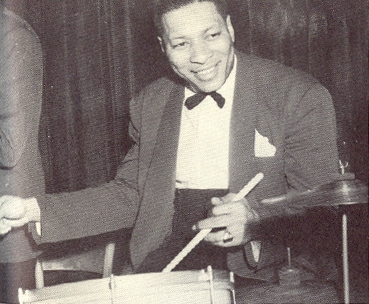
One of the top drummers of the Swing era, Sidney Catlett ("Big Sid") was born on 17 January 1910, in Evansville, Indiana, and attended high school in Chicago. After working in local bands a few years, he moved to New York in 1930. He subsequently played with Benny Carter (1933), McKinney's Cotton Pickers (1933-34), the Jeter-Pillars band of St. Louis, Fletcher Henderson's Grand Terrace band (1936), Don Redman (1936-38), and Louis Armstrong's big band (1938-42). Catlett also briefly played with Benny Goodman (1941). From 1944 to 1946, he was leading his own combos in California and New York City and doing extensive session work for several labels. (He is in particularly good form, and particularly well recorded, on the sessions that he made for Keynote in 1943 and 1944, under such leaders as Lester Young and Coleman Hawkins.)
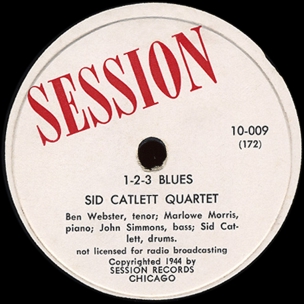
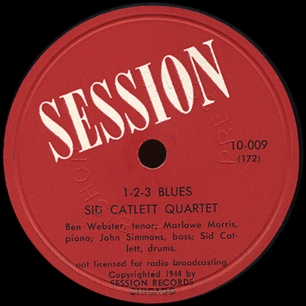
Ben Webster (ts except *); Sid Catlett (d); Marlowe Morris (p); John Simmons (b).
New York City, March 25, 1944
| WC-170-F | Perdido (Tizol)^ | Session 10-010, Onyx ORI 217, New World NW 284, Xanadu FDC5170 [CD], EPM Musique FDC5170 [CD], Classics [Fr] 1017 [CD] | |
| WC-171-F | I Surrender Dear (Barris-Clifford)^ | Session 10-010, Onyx ORI 217, New World NW 284, Xanadu FDC5170 [CD], EPM Musique FDC5170 [CD], Classics [Fr] 1017 [CD] | |
| F-172; WC-172-F | 1-2-3 Blues (uncredited) | Session 10-009, Onyx ORI 217, Classics [Fr] 1017 [CD] | |
| F-173-A; WC-173-AF | I Found a New Baby (Williams-Palmer)* | Session 10-009, Onyx ORI 217, Classics [Fr] 1017 [CD] |
Our proximate discographical information comes from Lord's Jazz Discography Volumes 4 and 24. The session was listed in Metronome (June 1944, p. 25) albeit without a recording date. Session 10-010 from this session was a 10-inch 78 issued under Ben Webster's name; Session 10-009 was released under Sid Catlett's.
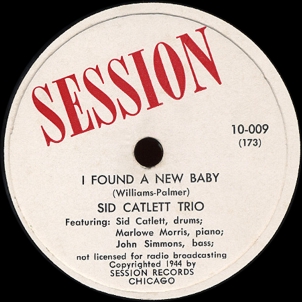
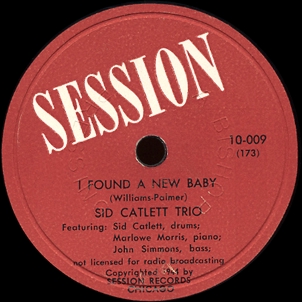
Session 10-009 is known in copies with an incised F prefix in the trail-off area (the first pressing), and in copies pressed by Bishop with a red label and a stamped WC prefix in the trail-off area. At least one copy (from the later pressing, by Bishop) ended up with on red label and one white one.
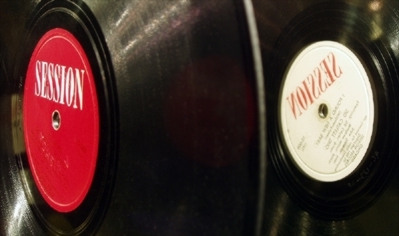
Session 10-010 is known in copies pressed by Bishop with a WC prefix to the stamped matrix number; there may also be pressings with an F prefix, but if so these still need to be verified by collectors.
A review of Session 10-009 in Metronome (October 1944, p. 23) was none too encouraging. "Lots of good Ben Webster on the 1-2-3 Blues, which is cramped by some measures of unoriginal bass playing (by John Simmons) and of unnecessary drumming (by Sid Catlett). Coupling, without Ben, is leavened by Marlowe Morris's facile piano, lowered by the drumming which occupies most of the side. Though it is excellent drumming, it has no conceivable musical interest." "1-2-3 Blues" rated a B from the reviewer, "I Found a New Baby" no better than a C+.
Down Beat, in the person of John Lucas, riposted (October 1, 1944, p. 8) that "On the blues side Ben Webster is in one of the mellowest, most relaxed grooves he's ever struck on platters. After a piano intro, Ben solos easily and beautifully... Webster's absence on the second side leaves only a trio of rhythm men, but what rhythm men!" Where Metronome saw no musical point to Catlett's drum soloing, Down Beat's reviewer paid special attention to both the brush solo and the stick solo, which were in any case not the only solos on the track. How could a true jazz aficionado disdain a solo by Sid Catlett at the height of his powers? (Confusingly, George Hoefer's announcement that Session 10-009 and 10-010 were "ready for release" actually followed in the October 15 issue, p. 12. Hoefer also praised the sides as "very relaxed" and "showcas[ing] [Webster's] technique and style better than than any records I've heard.")
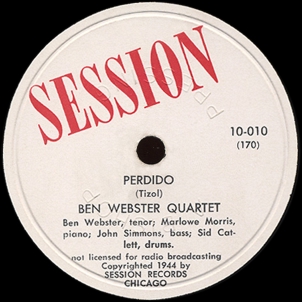
On December 15, 1944, Session 10-010 was covered in Down Beat's record review section, "Diggin' the Discs." "Ben has wanted to do a full plate of Tizol's Perdido for a long time, and he shows why on this superb version. Webster's first solo is almost straight, his second a brilliant elaboration of the theme. I haven't heard a drummer and bassman work together as Catlett and Simmons do here since the days of the Goodman Sextet, and then the rhythm men were these same two!... Morris introduces Surrender, then moves out of Webster's way as Ben goes into a chorus rich in tone and feeling. Catlett's drums break into double-time, paying the way for Ben's jump solo. Marlowe's bridge is much too florid, but Ben and Big Sid are great at the finish" (p. 8).
A capsule review in the Jazzette (March-April 1945, p. 21) gave both 78s the thumbs-up:
The first two are under Catlett's name with Webster sitting out "Baby' to let Marlowe Morris' piano shine and Catlett's drums be featured in a tasty, if lengthy, solo. "Blues" is an interesting original with Webster's tenor very relaxed and Johnny Simmons' bass steady. The only drawback to "Surrender" is the banal use of a double-timed final chorus. Ben's even-toned horn jumps beautifully through the Tizol opus which is the best of the group. These sides are well recorded, too, which is a relief after some of the recent releases.
Nothing from this session was released—or even scheduled for release—on Pax. The sides had to wait till the 1970s for reissue.
Onyx ORI 217 was an LP released in 1972 or 1973 under the title Coleman Hawkins / Nat Jaffe / Ben Webster / Don Byas: 52nd Street Volume 2.
New World NW284 was an anthology LP from the late 1970s titled Jazz in Revolution: Big Bands 1940's.
Xanadu and EPM Musique FDC5170 were identical CDs titled 6 Classic Tenors. Xanadu reissued material that had previously appeared on Onyx.
Classics 1017 is a French CD titled Ben Webster 1944-1946.
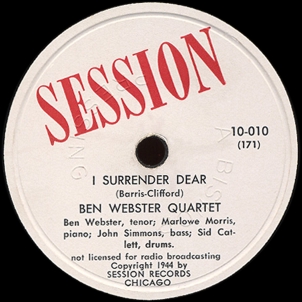
The same quartet had recorded in New York for Commodore a week earlier. Phil Featheringill indicated in his May 1944 "Chicago Telescope" column that Catlett was bringing a group to Chicago and that he would use Eddie Johnson (see the next session) on tenor sax, but nothing came of this. Catlett did not take a gig in Chicago, and Johnson stayed put in the house band at the Rhumboogie.
Sid Catlett went on to record as a leader for Delta (later in 1944), Super Disc (1945), Capitol (1945), and Manor (1946) at the helm of different combos. From 1947 to 1949, he was a charter member of the Louis Armstrong All-Stars. After leaving Armstrong, Catlett, who was suffering from heart trouble and wanted to avoid the rigors of the road, settled in Chicago. In 1950 he took up long-term engagement at Jazz Ltd., and was still in town when he died suddenly from a heart attack on March 25, 1951. The Down Beat obit hailed him as "one of the most competent and tasteful drummers in jazz."
At the time of his appearance on Session, Ben Webster had only just begun appearing as a leader (with a combo for World Transcriptions on February 8, 1944); he would continue to record prolifically until shortly before his death in 1973.
Featheringill's remaining recording ventures would all take place in Chicago. For his next block of studio time, he assembled a group of up-and-coming local Swing musicians. Apparently he had a much easier time recruiting the players than he did naming the group.
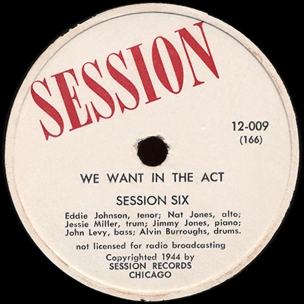
Jesse Miller (tp); Nat Jones (as); Eddie Johnson (ts); Jimmy Jones (p); John Levy (b); Alvin Burroughs (d).
Chicago, April 2, 1944
| 164 | Big Oaks from Little Acorns Grow^ | Session 12-008 | |
| 165 | I Wished on the Moon^ (Parker-Rainger) | Session 12-008 | |
| F-166 C | We Want in the Act |
Session 12-009 | |
| F-167 | Yesterdays (Kern-Harbach) | Session 12-009 |
The session was announced in a brief item in Down Beat on June 5, 1944, and included in "Metronome's Exclusive Jazz Discography" (June 1944, p. 25). The group was billed in those announcements as the Chicago Jazzmen, and 12-008 was reviewed under the same artist designation in October 1944. Just a little later, in the Down Beat review, the band was referred to as the Little Acorns. After all that indecision, Featheringill changed the group's name to the Session Six before releasing 12-009.
Many thanks to William H. Korst for alerting us to this session, which Eddie Johnson has confirmed playing on. Our listing ultimately derives from Charles Delaunay's New Hot Discography (1948, p. 497), which Korst also alerted us to. The listing (which gives the title of 164 as "Big Oaks") has been passed on to later discographers; for instance, Lord includes it in his Jazz Discography, with "In the Act" as the title for 166.
Korst was unable to obtain a copy of Session 12-008 from Featheringill while the record company was in business. Yet 12-008 is not a complete phantom, for it was reviewed in Metronome, October 1944, as by the Chicago Jazzmen, and in Down Beat on November 1, as by the Little Acorns. Collectors, please let us know whether you have ever come across Session 12-008.
Metronome reviewed the elusive Session 12-008 in its October 1944 issue, p. 24. The review supplies the long title "Big Oaks from Little Acorns Grow"; "Big Oaks" gets a grade of B- and "I Wished on the Moon" rates a mere C+.
An excellent group of little known Chicago musicians make up the complement of this record, but somehow their individual excellences don't coalesce and the finished product is sadly mediocre. There is some fair Nat Jones alto (he used to play such fine clarinet with Duke Ellington) on Moon, a somewhat interesting piano-bass duet lost in the bad recording, and lot of formless force displayed by Eddie Johnson's tenor saxophone. On the better coupling, Jesse Miller gets a break back of his trumpet via an ensemble riff, Nat plays some more, as does Eddie, and a lovely solo by Jimmy Jones, Stuff Smith's brilliant pianist, fades annoyingly into the background along with the rest of a first-rate rhythm section, John Levy, bass, and Alvin Burroughs, drums.
The next month in Down Beat, John Lucas righted things for the trad camp, giving 12-008 a much more favorable treatment:
Oaks, as solid as Hickory, is an original jump instrumental. It opens with some neat, tricky ensemble. Nat Jones follows with some very Carter-ish alto, and I don't mean ish! There's nothing startling about Jesse Miller's Eldridge-like trumpet get-off, but Eddie Johnson's tenor digs deep and dirty for three choruses in arow, rolling on and on in a fashion that's strictly on the Cobb. John Levy, Phil Featheringill's favorite bass player, executes a very sensible solo quite perfectly in tune as Jimmy Jones tinkles madly in the distance. The closing ensembles allow Alvin Burroughs to break out with some of his fly snare-work. Moon, by Parker and Rainger, opens with a Miller trumpet intro which sets the slow tempo very cleverly. Jones' alto, sounding lead-like, resembles Hilton Jefferson's and Will Smith's even more than Tab Smith's here. Jimmy Jones, like Levy a member of the Stuff Smith Trio, plays a piano that's either out of the world or set way back in the next room. Tenorman Johnson sits right down on his chorus, speaking very smoothly against a four-four backdrop. Judgment-Day Jesse takes it out, dragging his coda behind him. Some of these men are bound to climb aboard the gravy-train soon, the rest will probably remain on the wrong side of the tracks commercially for many moons to come. Hats off to Session for giving them all a break! (November 1, 1944, p. 8)
At least the reviewers agreed that Jones' piano was off-mike!
Session 12-009 was a 12-inch 78-rpm single that achieved slightly wider circulation. We know of copies of 12-009 with matrix numbers incised in the shellac, and the F prefix. There could be later pressings from Bishop with the WC prefix; collectors, what say you?
12-009 was released in December 1944. Session Record Shop advertised in The Jazz Session for January-February 1945 (p. 24).
Lucas in Down Beat reviewed Session 12-009 as a Swing record (December 15, 1944, p. 8). He offered a moderately positive description of the proceedings: "Eddie Johnson's tenor chorus can't compare with Hawkins' famous solo [on "Yesterdays"], but it moves along smoothly just the same. Miller and Johnson alternate to take it out. We Want In starts off with a drum intro from Alvin Burroughs, then moves into a an ensemble passage featuring Jesse on trumpet. Nat and Jesse and Eddie all solo, sounding respectively like Carter and Eldridge and Hawkins. Jimmy's piano is mad, and Al's drumming fly enough as the ensemble finishes the number." Apparently "fly" was the first adjective that came to Lucas's mind when he heard Alvin Burroughs.
12-009 also rated a one-paragraph capsule in the Jazzette (February 1, 1945, pp. 14-15):
If a jam session was ever recorded ["We Want in the Act"] is what it would sound like. On the original, Eddie Johnson plays gutty, driving tenor and Jesse Miller screeches with enthusiasm. Alvin Burroughs, John Levy, Jimmy Jones, and Nat Jones also give good accounts of themselves and the final wild ensemble is in the best jam session tradition complete with Alvin's slightly overemphasized drumming. "Yesterdays' finds the ensemble better integrated and Johnson plays very pretty tenor. A more than capable job by a group of relatively unknown musicians.
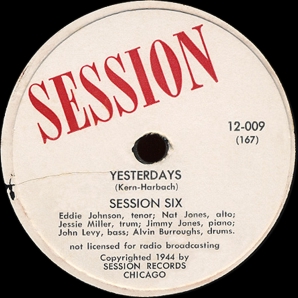
Korst notes that at the time Jimmy Jones and John Levy were in the Stuff Smith Trio at the Garrick Show Lounge.
Alvin Burroughs had been a member of the Milt Larkin aggregation at the Rhumboogie, during 1942 and 1943. At the time of the recording, he was working the basement room of the Garrick (the Downbeat Room) with Red Allen's great jump combo.
Jesse Miller Jr. was born in Houston, Texas, on August 16, 1921. He graduated from DuSable High School in Chicago, where he got his musical training from the legendary Captain Walter Dyett. In June 1940 he joined Local 208 of the Musicians Union. He played in the bands of Tiny Bradshaw and King Kolax and by this time was leading his own group at Joe's Deluxe Club (see Featheringill's mention in his May 1944 column; Miller posted a contract with Local 208 for 4 weeks at Joe's Deluxe, with options, on April 6, and a second on May 11). The Joe's Deluxe Club band consisted of Albert Atkinson (alto sax), Kermit Scott (tenor), Argonne Thornton (piano), Walter Buchanan (bass), and the 17-year-old Ike Day (drums). Miller would soon hit a rough patch: Scott was kicked off the job and sent back to New York, and Day was booted out of Local 208 because both had gotten drunk and refused to play in the early morning hours of May 13 (see the Local 208 Board meeting minutes for May 18, 1944, p. 1).

The trumpeter's highest-profile engagement came when he took over for Red Saunders as bandleader at the Club DeLisa, from June 1945 through February 1946. In the fall of 1949, Miller was a member of the combo led by tenor saxophonist Gene Ammons, in which capacity he appeared on Ammons' final session for Mercury. These four sides from October 4, 1949 are the only other ones on which Miller is known to have played. He was given no solo space but was well recorded: note his muted accompaniments on "Ev'rything Depends on You" and "When You're Gone." Shortly after the Ammons session, Miller became ill with Hodgkins Disease, for which there was little in the way of effective treatment in those days. He died at County Hospital in Chicago from complications of his cancer on January 24, 1950 (Chicago Defender, January 28, 1950, p. 2).
Nat Jones worked with Red Saunders in the early 1940s, and also spent some time in the Duke Ellington Orchestra in 1943. In late 1944 and early 1945, he was playing first alto in the Dream Band at the Rhumboogie alongside Eddie Johnson. Jones' tenure in the band may have overlapped a little with Charlie Parker's time there, but he was soon replaced by Johnny Houser. The Down Beat from June 5, 1944 had Eddie Johnson working with a bandleader named "Dickenson" (a garble for Carroll Dickerson, who had actually just given up attempting to lead the Dream Band) and Nat Jones working with Red Saunders. But when Saunders left the DeLisa to lead a combo, Antonio Cosey was his altoist. Jones would return to Saunders' band for a few months in 1946, while Red was still leading a sextet. That same year, Jones recorded on at least two sessions for Freddie Williams' Hy-Tone label, one with singer Bing Williams and one with guitarist Floyd Smith.
Amazingly, nothing from the Chicago Jazzmen session has even been reissued.
After the Chicago Jazzmen / Session Six, matrix numbers 168 and 169 remain unaccounted for.
James Ostend "Pete" Brown was born in Baltimore on November 9, 1906. His first instruments were piano, ukulele, and violin. According to George Hoefer Jr.'s profile of Brown in "The Hot Box" (Down Beat, October 15, 1943, p. 16), "While playing violin in the pit band of a theater, Pete decided he could make more money playing an alto saxophone. So around 1924 when he was eighteen he started playing around on both the alto and tenor becoming proficient on the former." In 1927 he moved to New York, where he quickly became established as a jazz musician and saxophone teacher. Brown avoided the big bands, went on the road infrequently, and worked exclusively in Swing or jump combos. Besides groups under his own leadership, he was a member of the very first John Kirby Orchestra in 1937 and worked in a combo led by trumpeter Frankie Newton.
Pete Brown was in Chicago in June 1943, leading a combo at Club Silhouette; his contract for 2 weeks was posted with Local 208 on June 3.
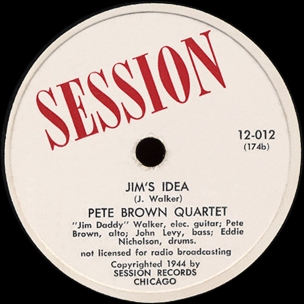
Pete Brown (as); Jim Daddy Walker (eg); John Levy (b); Eddie Nicholson (d).
Chicago, April 23, 1944
| 174-B | Jim's Idea (Walker) | Session 12-012, Classics [Fr] 1029 [CD] | |
| 175 | Eddie's Idea | Session 12-013 [?] | |
| F-176 | Pete's Idea (Brown) | Session 12-012, Classics [Fr] 1029 [CD] | |
| 177 | Jim Daddy Blues | Session 12-013 [?] |
The session date, personnel, and titles appeared in Metronome, June 1944, p. 25.
This session is listed in Tom Lord's Jazz Discography Volume 3. Lord gives the same number to a 78 from this outing (12-013) as he does to the first release from the J. C. Higginbotham session (see below). He is right here and wrong in his Higginbotham listing (the Higginbotham release was 10-013).
Session 12-012 was released in December 1944 and first advertised in the January-February 1945 issue of The Jazz Session (p. 24). All known copies have a white label and an F prefix to the matrix number, which is incised in the trail-off shellac (albeit in this case the F appears on just one side of the 78). All indications are that 12-012 is very rare.
A one-paragraph review of 12-012 in the Jazzette (February 1, 1945) was favorable: "At last, Pete's unique alto is given plenty of space, and he certainly makes the most of it. His humorous, trumpet-styled horn jumps like mad on both sides backed by John Levy's powerful bass and Eddie Nicholson's under-recorded drums." The reviewer praises Jim Daddy Walker's solo contributions (perhaps unwisely repeating Walker's claim to have taught Charlie Christian) and concludes by noting that "'Jim's Idea' is really 'Temptation' but has the best solos by both the stars" (p. 13).
Session 12-013 was announced at the time, but we have no confirmation of its release.
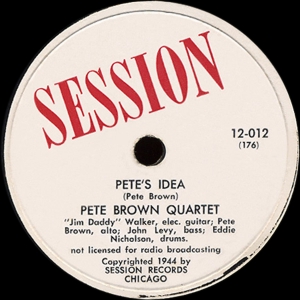
These 4 tunes, recorded in an easy-going jam-session format, constituted Pete Brown's third effort as a leader. The first, for Decca in New York on February 9, 1942, produced the famous "Mound Bayou." On January 16, 1944, he led a transcription date in Chicago with a band that included Jonah Jones on trumpet, Zed Jackson on piano, Dallas Bartley on bass, and Eddie Nicholson on drums. Anatol Schenker's notes to Classics 1029 mention that "In early 1944, Pete worked with a combo at Garrick's [sic] Lounge and the Silhouette in Chicago."
Brown subsequently recorded four different times in New York for Savoy (1944-1945) and once for Keynote (July 1944). Though his phrasing was much imitated by saxophonists in the genre he didn't prosper during the heyday of rhythm and blues. After long a period of inactivity he made an LP for Bethlehem (1954), appeared on a Newport Jazz Festival collection (1957) and did a final LP for Verve in 1959. In his last years he doubled on the tenor sax. Pete Brown died in New York City on September 20, 1963.
Also worthy of note is guitarist James "Jim Daddy" Walker, who was given a special profile in George Hoefer Jr.'s "Hot Box" column in Down Beat, December 1, 1944. (So little has been written about Walker that we have cribbed liberally from this source.) Hailing Walker as "one of the best jazz guitars to come along" (p. 11), Hoefer noted that Walker had played banjo in Jap Allen's Kansas City-based Cotton Club Orchestra, which also included Ben Webster and Clyde Hart. Subsequently Walker switched to guitar and worked in the Clarence Love Orchestra out of Dallas. Walker claimed to have jammed with the young Charlie Christian in Oklahoma City and shown "the younger Charlie his riff structures and style." He worked with Count Basie in 1935 but was on the road in another band when Basie and company made their fateful trip east in 1936. In 1942, Walker began a two-year engagement at the Silver Frolics on Chicago's West Side with a group called the Four Tons of Rhythm. The Four Tons consisted of Bill Saunders (clarinet and saxes), Clint Weaver (bass), and James Walter Scott ("straight rhythm guitar and Hawaiian guitar"), along with Walker, who was also the group's arranger. Saunders and Weaver were, like Walker, originally from KC; Scott was originally from Omaha.
Not long before Jim Daddy Walker recorded with Pete Brown, Billboard reviewed a set by the Four Tons at the Silver Frolics on April 15, 1944 (p. 21; the next review was of the Stuff Smith Trio at the Garrick). The vocal/instrumental band was said to have formed in 1939 and to have been at the Frolics for 16 months. "The men all sing vocals and harmonize, and with the proper publicity could give the Ink Spots a run for popular favor."
Hoefer's December 1 profile notes that Walker's first released recording was Session 12-012. Hoefer stated that "One side Jim's Idea is a Walker original and features plenty of his fine guitar." 12-013 was not out when Hoefer mentioned its companion in his column; as far as we can determine, it was never released, and it has eluded reissue compilers.
Two sides from this meeting (drawn, of course, from 12-012) were reissued for the very first time in 1998 on Classics 1029, Pete Brown 1942-1945. We hope that masters of the other two are still extant.
Session resumed its traditional jazz activity with a session led by veteran trumpeter Punch Miller. Ernest "Punch" Miller was born in Raceland, Lousiana (on June 10, 1894 or December 24, 1897, depending on which source you believe). He worked with legendary New Orleans bandleader Jack Carey ("Tiger Rag" was once known as "Play Jack Carey"), and in army bands during his service in World War I. In 1926, he moved to Chicago, where he worked but did not record with Freddie Keppard and Jelly Roll Morton, and did both with Al Wynn. Platooning in Tiny Parham's big band with Roy Hobson, who wasn't nearly so good a jazz player, Miller made three of Parham's recording sessions, which used a cut-down ensemble, in 1928-1929; he recorded in 1930 with Frankie Franko's Louisianians. Up through the mid-1940s he often led his own bands in Chicago. In 1941, John Steiner recorded his trio live at the H&T Tavern on a portable disk-cutter; four of the six sides were belatedly released (probably in 1949, in a highly limited edition) on S D, then a different selection of four in 1952 on Steiner's revival of the Paramount label.
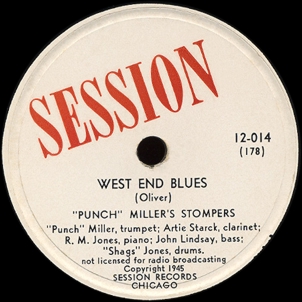
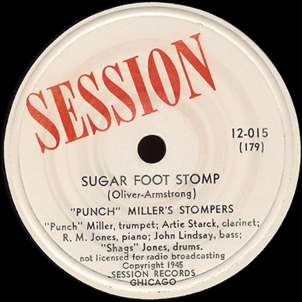
Ernest "Punch" Miller (tp); Artie Starks (cl); Richard M. Jones (p); John Lindsay (b); Clifford "Snags" Jones (d).
Chicago, June 12, 1944
| WC-178 B-1803 | West End Blues (Oliver) | Session 12-014, Pax LP6010, Jazz Selection JSLP 50.020, Carrousel CAR19, Gannet CJR1002 [CD] | |
| WC-179 B-1804 | Sugar Foot Stomp (Oliver-Armstrong) | Session 12-015, Carrousel CAR19, Gannet CJR1002 [CD] | |
| WC-180 B-1805 | Muscle Shoals Blues (Thomas) | Session 12-015, Carrousel CAR19, Gannet CJR1002 [CD] | |
| WC-181 B-1806 | Boy in the Boat (Williams-Waller) | Session 12-014, Pax LP6010, Jazz Selection JSLP 50.020,Carrousel CAR19, Gannet CJR1002 [CD] |
The session rated an entry in Metronome's ongoing jazz discography, August 1944, p. 27. In early publicity the group was referred to as Punch Miller and His South Side Stompers but the record labels condensed the name to Punch Miller's Stompers. The labels misspell Artie Starks' last name and alter the drummer's nickname to "Shags."
In the August 1, 1944 issue of Down Beat, George Hoefer, Jr., devoted part of his "Hot Box" column (p. 11) to Miller's forthcoming releases. Reaching a little too hard for a parallel to the rediscovery of Bunk Johnson (who had lost all of his teeth, was completely retired from music, and had been found living in obscurity in a country town), Hoefer mentions traditional jazz maven William Russell "finally" locating Miller in Chicago in 1940, leading to coverage in Hoefer's column on December 15 of that year. "Thereupon the New Orleans horn blower again disappeared, but good. In 1942, collector Med Havens in the army, ran into Punch playing with a tent show, in Spartanburg, S. C. This June on a Saturday, Punch Miller again was found on Chicago's vast South Side. By Tuesday he had been rushed into a recording studio and his driving hornastics etched for posterity."
Revealing, too, is the way Hoefer moves from commenting on Miller's technique to giving him a place in the public duel between Moderns and Moldy Figs: On the Sessions, Miller "asserts feeling, although his techique is sometimes quite weak. The set is worthy cannon fodder to add flames to the Ulanov-Feather vs. Russell-Williams controversy." Eugene Williams was involved in recording and promoting Bunk Johnson. And of course, Barry Ulanov and Leonard Feather both wrote for Metronome.
Although Hoefer had given a complete rundown of the titles on Session 12-014 and 12-015 on August 1, 1944 (he had obviously listened to the test pressings), and he later announced that they would be available in mid-July 1945, the 12-inch releases did not hit the market till nearly two years after they were recorded. They were among the first records to be pressed at Bishop, which opened in April 1946. John Lucas of Down Beat finally reviewed them on May 6, 1946, including them in a roundup of New Orleans-style jazz records released so far that year. "Although Art [Starks] and the late R. M. [Jones] furnish plenty of interesting melodic twists, and Johnny [Lindsay] and Snags [Jones] supply a tremendous rhythmic lift, it's Miller who really makes these sides so wonderful. Like Kid Rena, Shots Madison, and Louis Armstrong, Punch learned a lot from Bunk in the old days and added a lot more in the intervening years. His drive on Sugar Foot and his phrasing on West End place him above even George Mitchell and Lee Collins as the closest thing we have to Satchmo the King!" (p. 19). The reference to Willie Geary "Bunk" Johnson was de rigueur among traditionalists at the time.
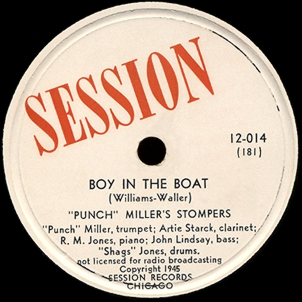
Session 12-014 has a 1945 copyright date, but it was released in 1946. Known copies of 12-014 carry white labels, stamped matrix numbers with the WC prefix and additional incised numbers starting with a B.
Session 12-015 was also released in 1946, despite a copyright date from the previous year; the copies we have seen also carry WC number and B numbers in the shellac. All of these records were manufactured by Bishop pressing company, as is indicated by both the WC prefix and the B prefix. The Bishop embossing on the labels, which we see on so many 10-inch Session 78s, is absent from these two singles.
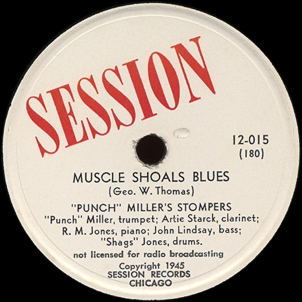
Pax LP6010 was released in October 1954 as New Orleans Stylings: Richard M. Jones Jazz Wizards and Punch Miller Stompers. There was room on Side B of this 10-inch LP for just two of the four Miller sides; Lord incorrectly puts all four of them on the LP.
Jazz Selection J.S.L.P. 50.020 needs checking, because other two items in this series of 10-inch LPs put out by French Vogue were straight reissues of Pax LPs, and we wonder why this one would not have been. Details, anyone?
Gannet CJR1002 is a British CD compilation released under the title New Orleans to Chicago: The Forties. It also includes the Richard M. Jones session above, along with material recorded for other labels by Preston Jackson, Karl Jones, and Little Brother Montgomery.
In 1947, Punch Miller moved his base of operations to New York City, where he would next record for Savoy (two sessions that year); for the next decade he toured in circus bands and R&B combos. After returning to New Orleans in 1956 to participate in the traditional jazz scene there, he recorded fairly often up through 1969, becoming a regular at Preservation Hall, and was featured in a documentary film in 1971. Punch Miller died in New Orleans on December 2, 1971.
In his "Hot Box" column for July 1, 1945 (p. 11), George Hoefer, Jr., profiled Clifford "Snags" Jones, who had been on both this session and the 1941 live recordings with Punch Miller. (The occasion for the column was the promised release of Session 12-014 and 12-015, set for mid-July, but the schedule ended up slipping on these.) Born at 2310 2nd Street, New Orleans, in 1900, Clifford Jones began playing the drums while in elementary school. (His nickname "Snags" was a slightly more decorous version of "Snaggletooth.") His first professional job with was with the legendary (but unrecorded) cornetist Buddy Petit. Subsequently Snags worked for several years in Jack Carey's band and also gigged with Papa Celestin and A. J. Piron. In 1922 he joined the migration to Chicago, where he initially worked under another New Orleans expatriate named Tig Chambers. In 1924 he was a member of King Oliver's Creole Jazz Band while it still included Louis Armstrong. He made his first recordings in 1926, providing accompaniment for blues singers with Richard M. Jones at the piano. In 1928, he recorded with Junie C. Cobb, Jimmy Wade, the Dixie Four, and the State Street Ramblers. After a sojourn in Milwaukee, he labored in relative obscurity in Chicago for most of the 1930s.
Snags subseqently recorded with Preston Jackson for Victor (October 31, 1946; two of these sides, which also happen to have reissed on the abovementioned Gannet CD, featured him as a blues singer); during that same year he worked with Darnell Howard and Bunk Johnson. He died in Chicago on January 31, 1947.
According to George Hoefer, Jr., in the April 15, 1944 issue of Down Beat, Session had further ambitious plans to record Chicago-based musicians who been on the scene in the 1920s: cornetist George Mitchell, drummer Fred "Tubby" Hall, trombonist Roy Palmer, pianist Herb Morand, drummer Jasper Taylor, and pianists Jimmy Bertrand and Dave Peyton (plus one Kid Brown, whose instrument we don't know). Nothing ever came of these efforts.
Jimmy Jones (p); John Levy (b).
Chicago, June or July 1944
| 182 | Improvisations A2 | Session 10-011 [?] | |
| 183 | Improvisations D2 | Session 10-011 [?] | |
| 184 | Improvisations B | Session 10-012 [?] | |
| 185 | Improvisations F | Session 10-012 [?] |
The session was first listed in Metronome's serial discography in November 1944; the date was given there as "August 1944," which has been carried forward uncritically by later discographers. Since the Stuff Smith Trio with Jones and Levy opened at the Onyx Club in New York City on August 4, 1944, and the band traveled by train from Chicago to get there, this date is obviously too late. Our conclusion is that the sides were cut earlier in the summer.
We doubt that either Session 10-011 or 10-012 was ever issued; neither of our Session specialists, John Holley and Konrad Nowakowski, has seen a copy of either. Nor has this material ever appeared elsewhere.
This session is listed in Tom Lord's Jazz Discography Volume 11. (Lord repeats the listing under John Levy's name, but leaves off the matrix numbers the second time around!)
James Henry Jones was born in Memphis on December 30, 1918. Growing up in Chicago, he initially took up the guitar but switched to piano as a teenager. His first prominent gig was as a member of Stuff Smith's trio at the Three Deuces in Chicago, the year before this session. In August 1944 he moved his base of operations to New York City, where he recorded with Stuff Smith and later worked with J. C. Heard. From 1947 to 1958 he was Sarah Vaughan's regular accompanist. He recorded extensively with many other leaders from 1945 to 1960. In the later part of his career he devoted most of his time to arranging and conducting; among other things he conducted a show for Duke Ellington and worked for a time as Ella Fitzgerald's music director. He died in Burbank, California on April 29, 1982.
Jimmy Jones recorded sparingly as a leader; these Session 78s would have been the very first to carry his name. In 1946 he cut two sessions in New York for HRS and in 1947 he recorded extensively for the Wax label. Beyond these he was responsible for a 10-inch LP done for Vogue in Paris (1954), a trio session for Gene Norman Presents (exact date unknown), and 1957 sessions for an Atlantic LP that has never seen release.
John O. Levy was born in New Orleans on April 11, 1912. Growing up in Chicago, he initially played violin and piano, settling on the bass when he was 17. He worked with Earl Hines, Tiny Parham, and Red Saunders, among other leaders, during the 1930s. He began to get national exposure in 1943 when he joined Stuff Smith's trio. Besides appearing alongside Jimmy Jones in the Session Six, Levy had also gotten the call to work with Pete Brown for Session. Along with Jimmy Jones, Levy moved to New York with Smith at the beginning of August 1944. Levy went on to record with several leaders in the late 1940s, and worked as a member of Billie Holiday's band in 1948. From 1948 through 1951 he was a regular member of George Shearing's quintet.
In 1951 John Levy gave up playing to become a manager for such artists as George Shearing, Sarah Vaughan, Nancy Wilson, and (later) Roberta Flack, continuing in this capacity into the 1990s. Levy's clients at the time, who included Nancy Wilson and Joe Williams, presented a tribute to him at the Beacon Theater in New York in June 1998. (We must note that it was a different John Levy—middle initial H.—who became notorious as the abusive boyfriend of Billie Holiday.)
Around the time that their duet session was cut, Jones and Levy ran afoul of a rule against jamming, which Musicians Union Local 208 was quite serious about enforcing. Also caught in the net were their employer, Stuff Smith, and the leader on the last recording session for the label, J. C. Higginbotham.
Mr. Gottlieb, co-partner of Tin Pan Alley, appeared before the Board representing Mr. Bennie Asher, to explain why members Stuff Smith, James Jones, J. C. Higginbotham and John Levy were permitted to jam on July 10, 1944.
Mr. Gottlieb explained that the above mentioned musicians were frequent patrons of Tin Pan Alley and always conducted themselves as gentlemen. He explained that on the night in question, the musicians, in the company of Mr. Horlich and two traveling musicians (a man and wife) came into his establishment after they were not able to visit the studio of their mutual friend Ken Griffin. After having several drinks, John Levy was asked to show the lady bass player certain passages on her instrument, which she had with her. Later the piano and trombone joined in. Stuff Smith did not play until near the end. He stated that no patrons were in the place, and they seemed to be entertaining themselves. (Minutes of the Board of Directors, Local 208, A. F. of M., July 20, 1944, p. 1)
For his final recording session, Phil Featheringill took advantage of the long residency that the Red Allen combo was enjoying in the Down Beat Room of the Garrick Lounge. Allen was under contract to a label, but his sidement were not so bound, and Featheringill used three members of Allen's group, under the leadership of J. C. Higginbotham. Trombonist J. C. Higginbotham was born in Social Circle, Georgia, on May 11, 1906. He took up the trombone at age 15 and embarked on a nomadic existence with various territory bands. Arriving in New York City in 1928, he joined the Luis Russell Orchestra, where he met his long-time associate, trumpeter Henry "Red" Allen. After leaving Russell in 1931, Higginbotham worked for Fletcher Henderson, Chick Webb, Benny Carter, and the Mills Blue Rhythm Band, finishing out the decade in the big band that backed Louis Armstrong. During this period, he was one of the top Swing trombonists, working in enough slurs and rips to suggest an older approach to his instrument. From 1941 through 1947, he was a regular member of Red Allen's jump combo. Subsequently he worked in a wide variety of small groups, retiring from music in 1969. J. C. Higginbotham died in New York City on May 26, 1973.
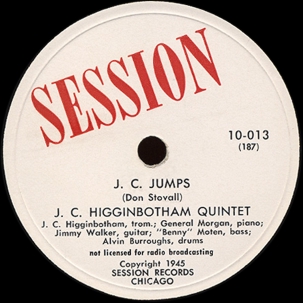
J. C. Higginbotham (tb); "General" Morgan (p); Jim Daddy Walker (eg); Benny Moten (b); Alvin Burroughs (d).
Chicago, September 14, 1944
| WC-186 B B-1807x | Dear Old Southland (Creamer-Layton) | Session 12-016, Pax LP6008 | |
| 187 | J. C. Jumps (Stovall) | Session 10-013, Pax LP6008 | |
| WC-188 A B-1808x | Confessin' (Neiburg-Daugherty-Reynolds) | Session 12-016, Pax LP6008 | |
| 189-C | Sporty Joe (Morgan) | Session 10-013 |
Phil Featheringill tipped off readers to his interest in Higginbotham in the May 1944 issue of Metronome. The lead item in his "Chicago Telescope" column noted that "after many weeks' bad health Higgy is now getting that sparkle in his eyes and that wonderful power back in his horn" (p. 14). Higginbotham was working Joe Sherman's Downbeat Room at the Garrick Theater Lounge in a combo led by Henry "Red" Allen (trumpet, vocals). The other members were Don Stovall (alto sax), Al Williams (piano), Benny Moten (bass), and Alvin Burroughs (drums). Red Allen was under contract to a bigger record company at the time, so Session couldn't record him. General Morgan was working regularly in Chicago as a leader or solo pianist in 1944, and "Jim Daddy" Walker (whose work Featheringill obviously admired) was gigging around town with the Four Tons of Rhythm.
The personnel and date were included in Metronome's ongoing jazz discography, November 1944 installment, and in George Hoefer Jr.'s "Hot Box" column in Down Beat for October 15. This was the last record date done for Session.
The Higginbotham session is covered in Lord's Jazz Discography Volume 9. What Lord incorrectly lists as Session 12-013 (12-013 was intended to be by Pete Brown's quartet) was reviewed in the July 1945 issue of Metronome (p. 18), where it was listed as Session "10-1013". The correct number was Session 10-013. The record was first advertised for sales in the July-August issue of the Jazz Session. Hoefer noted (October 15, 1944, p. 12) that "They made Sporty Joe & J C Jumps on ten inch and Confessin' and Dear Old South Land [sic] on twelve inch."
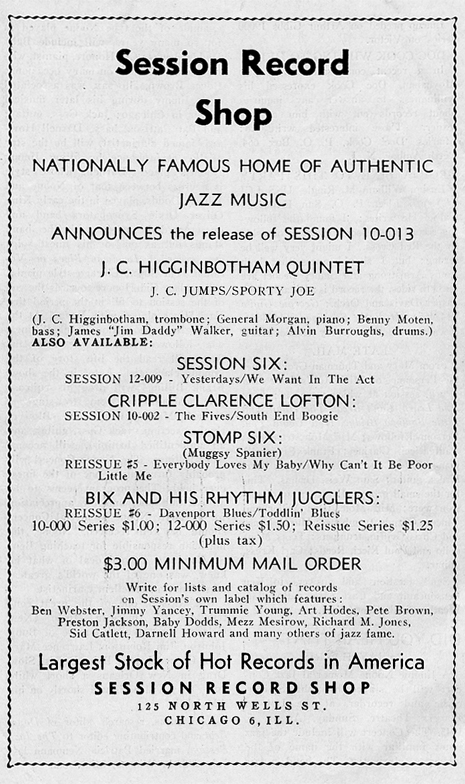
On Session 10-013 the original pressings bear a white label, a 1945 copyright date, and incised matrix numbers without prefixes. On these the 187 matrix is followed by a crossed out 189-C. There may be later pressings of 10-013 with the WC prefix; if so, these need to be traced.
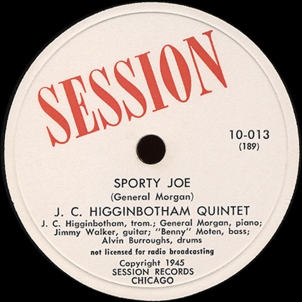
The Metronome reviewer gave both sides of 10-013 a C:
The Higginbotham Quintet is Red Allen band, minus Red, with General Morgan back on piano and Jim Daddy Walker added on guitar. Walker is a pleasant addition on Joe, but the ensemble is nowhere because of poor balance and, apparently, no attempt to tune up. Higgy jumps, as claimed, but without the musical interest he normally provides. Who threw the whiskey down the well? The record doesn't jell.
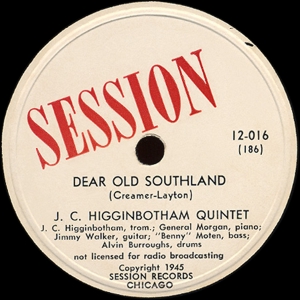
Session 12-016 also bears a 1945 copyright date, but the known copies were pressed by Bishop in 1946. They show signs of being made in the early days of The Bishop Presses, which opened in April 1946. They bear stamped matrix numbers with the WC prefix and incised numbers in the B-1800 series (perhaps these were stamper numbers?). The record was probably released around May 1946.
Pax LP6008 was scheduled for release in June 1954, but never appeared. The LP was to be titled Higgy & Trummy and was slated to include just 3 of the Higginbotham sides (all that would fit on one side of a 10-inch LP, leaving room for three by Trummy Young on the other); Lord incorrectly has "Sporty Joe" also appearing on the LP.
Did the Jazz Chronological Classics label, which reissued many other combo sides from Session, get around to 10-013 and 12-016 before it went out of business? We haven't found a Classics CD of Higginbotham from this period.
J. C. Higginbotham recorded only sporadically as a leader during his long career. In 1930, J. C. Higginbotham and his Six Hicks (who comes up with names like these?) made two sides for OKeh; the Six Hicks were a smaller group extracted from the Luis Russell Orchestra. Higginbotham also recorded for Blue Note in 1939 (during the sessions by the Port of Harlem Jazzmen), for HRS in 1945, in Copenhagen for Sonet in 1962, and finally in Atlanta for an outfit called Cable (1966). After 1940, Higginbotham's productivity was somewhat reduced by excessive drinking; the Metronome reviewer—either Barry Ulanov or Leonard Feather—was making a snarky reference to his proclivities. (Ulanov and Feather wrote all the reviews for Metronome under the tag "The Two Deuces.")
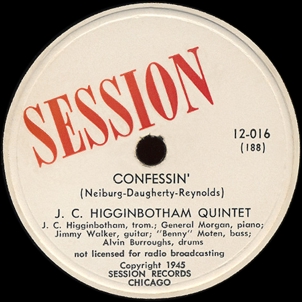
Session may have put out one various-artists 78. In an ad for Records, Inc. (Record Changer, December 1946, p. 14), Featheringill mentioned a "Premium Record No. 1" that was not for sale separately, and included "examples of both Dixieland and Modern small band music." We don't know whether this item, which could easily have coupled two sides already released on Session, came out as promised. Has anyone seen a copy?
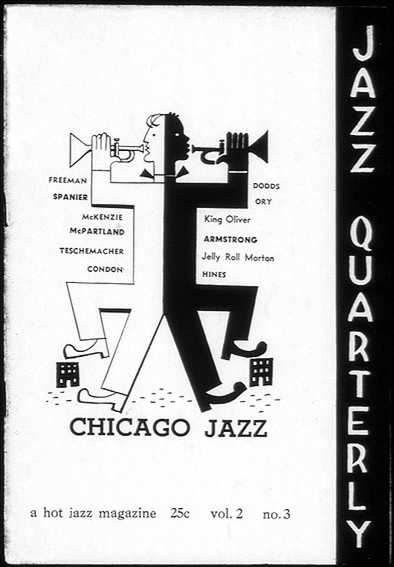
The J. C. Higginbotham sides were the very last to be recorded by Phil Featheringill's operation. Around the time he cut them, Featheringill was involved in producing a special issue of Jazz Quarterly. Hoefer announced its publication in his Down Beat column on February 15, 1945: "The Chicago Jazz issue of Jazz Quarterly is out. Judy Downs, editor, and Phil Featheringill, Lester Mouscher, associates, have worked up an interesting number sparked with Featheringill's unique drawings" (p. 11). Interestingly, one of the authors was a young pianist cited in the announcement as "Leonard Tristano."
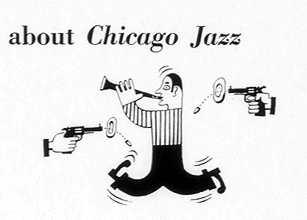
In the early months of 1945, Featheringill's primary musical activity was running traditional jazz sessions. According to his "Chicago Telescope" column in the March 1945 Metronome (p. 10), "This writer immodestly reports that he is conducting a series of Jam Sessions at the Zan-zi-bar on North State on Sunday afternoons from 2 to 5. Having featured R. M. Jones, piano; Punch Miller, trumpet; Preston Jackson, trombone; Baby Dodds, drums; Darnell Howard, clarinet and John Lindsay, bass, successfully on February 25, we now promise for March 4, Bud Jacobson, clarinet; Bill Stapleton, trumpet; Bud Wilson, trombone; Volly de Faut, clarinet; Lew Finnerty, drums; Tut Soper, piano and Pat Patterson, bass..."
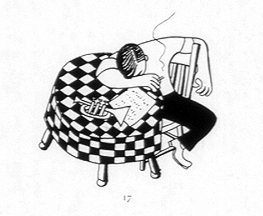
The February 25 session ended up being held with two substitute rhythm players: Ransom Knowling on bass and Tommy Taylor on drums. According to Hoefer's column for March 15, 1945, "Highlight of the afternoon was Estella 'Mama' Yancey signing How Long, How Long Blues." By summer the jam sessions were history; on July 15, 1945, Don C. Haynes, in a Down Beat item titled "Jazz Struggles for Survival in Chicago," referred to Featheringill's "short-lived series of sessions. These also were too erratic to be musically exciting, though in the sincerest jazz tradition." (p. 4) Session didn't record any of the get-togethers. Their place was quickly taken by a new series that John Steiner operated at the Uptown Playhouse Theater, though Steiner then ran into trouble with the Musicians Union and cut his series short in September. (Steiner had his own record company, S D, but any masters that he recorded from these events were destroyed when the theater burned down in April 1946.)
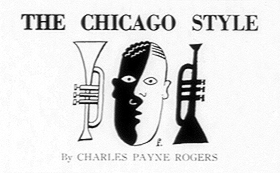
Phil Featheringill also contributed drawings to the Summer 1945 issue of Jazz Quarterly. The record shop continued to be active: the November 1945 issue of the Record Changer advertised an auction there, mostly of blues titles (p. 17).
The company was listed among the small jazz labels in the October 1945 issue of Metronome: "Run by Phil Featheringill, METRONOME'S Chicago correspondent, Session alternates between a.k. and modern jazzmen." On June 3, 1946, Session, now pressing its records in Southern California, made its final appearance in Down Beat's list of recording firms (p. 15).
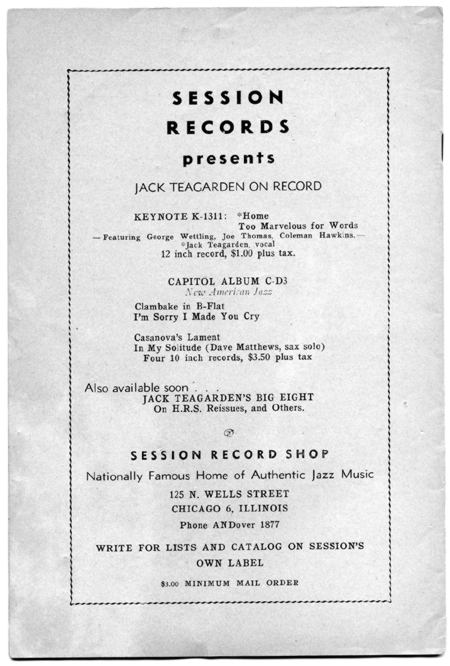
Around this time, Phil Featheringill made an attempt to expand his operations. In Down Beat for June 17, 1946, the "Chicago Band Briefs" column stated : "Phil Featheringill, head of the Session Record Shop and of the Session jazz label, has left for the west coast to handle the enlarged recording activities of his label" (p. 8). This seems on the money, though we don't know of any new recording efforts coming out of the move. The June 1946 issue of Metronome was the last to run Featheringill's column (which by this time was called "Chicago Roundup"). He was last mentioned on the magazine's masthead in the August 1946 issue. There was no editor's note or brief item to draw attention to Featheringill's departure.
Later Session pressings carry a WC prefix in the wax in place of the F prefix. The WC items were pressed by a company called The Bishop Presses, located in South Pasadena, California (its involvement is often signaled by the raised inscription "A Bishop Pressing" which pokes up under the label on one side of each record). Bishop stampers were usually either marked with a number in a B 1800 series, when the company was new, or a Dike-Polzin DP monogram. Session started using Bishop as soon as the company opened, in April 1946. The second-wave reissues (those with Reissue instead of Reissue Session on the label) bear a 1946 copyright date as well.
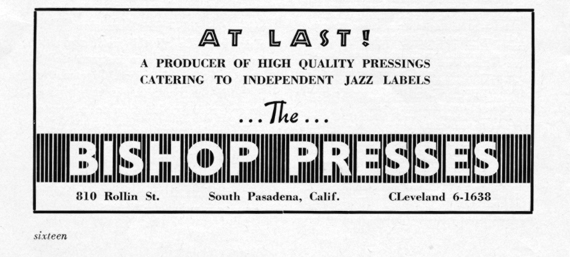
The first mention of Bishop was in Down Beat, June 15, 1945; one Tom Bishop was said to be establishing a company in South Pasadena, California, primarily to press records for Jump. (Jump, in turn, was an independent label with a trad jazz orientation. Its first two releases, by LaVere's Chicago Loopers, had come out in 1944.) However, the venture seems to have run into some delays. Bishop announced in an April 1946 advertisement in the Clef that its services were available "at last." The street address given in the ad was 810 Rollin Street, South Pasadena, California (this was the address Bishop stayed at through 1950). In those days, 810 Rollin Street just happened to house Jump Records and The Turntable, Distributors. Jump and The Turntable also used an address at Box 622, Hollywood 28, California. In December 1946, Bishop would begin pressing records for another boutique label from Chicago, S D.
Meanwhile, the final listing for the shop in the Chicago telephone book appeared in September 1946. The last magazine advertisement appeared in the September-October 1946 issue of a magazine called The Jazz Session (despite the name of the magazine and its roots among Chicago aficionados of traditional jazz, Featheringill had no editorial role in it). Dave Bell closed the store in November; the only contemporary announcement we've been able to find appeared in the Hot Club of Chicago News for that month. Soon enough, Dave Bell was being referred to as "one time prop of the Session Record Shop"—in Hoefer's column in Down Beat for December 16, 1946 (p. 9). In fact, the Record Changer for October 1946 ran an ad for Records, Inc., a mail-order operation whose mailing address was also PO Box 622, Hollywood 28. The ad proclaimed "an organization owned and operated by avid collectors" but Featheringill's business partners were not mentioned by name. In turn, Records, Inc. would run ads for Session releases in the December 1946 and March 1947 issues of the Record Changer.
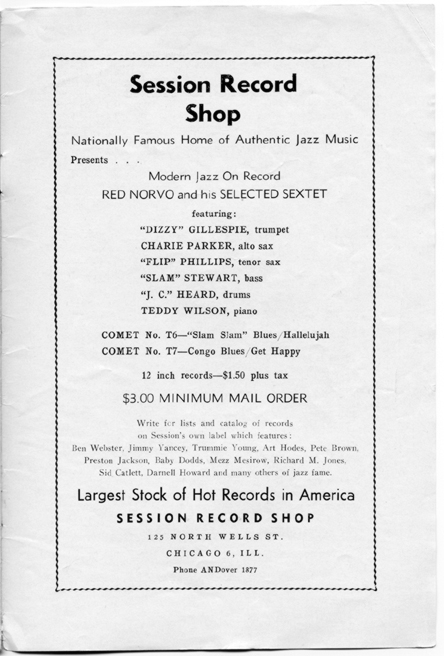
While the February 1, 1947 issue of Billboard, carried an outdated entry for Session using the old Chicago address, the 78s that were being shipped to retailers were now coming from Featheringill's mail-order operation in Southern California, or from the distributor he had bought into. On March 12, 1947, Down Beat ran a story titled "Phil Featheringill Sets Up L.A. Firm":
Los Angeles - Phil Featheringill, formerly operator of the Session Record Shop in Chicago, has set up Independent, an exporting and distributing firm here. To accomplish this, Featheringill bought out the interests of Ed Kocher and Clive Acker in the Turntable, Distributors. Outfit now handles a dozen various independent labels, will probably handle about 20 once full distribution is set. Dealers, through Independent Records, will be afforded the unique setup of ordering all labels at one time and in one shipment, with shipping charges being absorbed mainly by Independent. (p. 16)
Featheringill was still pressing Sessions in the first quarter of 1947. In fact, Session 10-005 and 10-015 were first advertised in the Records, Inc. ad in the Record Changer for March 1947. Each may have been pressed earlier, but if so the editions were extremely limited.
Featheringill soldiered on a little longer. An ad on p. 15 of the Record Changer, June 1947, changed the name of the mail-order business to Records Consolidated and the address to 1661 West Santa Barbara in Los Angeles. Featheringill put his name at the bottom of the ad, identifying himself as "sole owner." So far we have not found any ads for Independent Distributors.
These enterprises soon ran their course. Bishop stayed in business, and so did Jump, presumably still run by Kocher and Acker. Featheringill effectively announced that he had thrown in the towel on running a record label in October 1947, when Records Consolidated advertised rare originals from his 78 collection for sale in the Record Changer. By 1951, John Steiner's Paramount Distributors was disposing of remaindered Jimmy Yancey albums on Vinylite: "THIS IS JIMMY YANCEY $ 4.75 The last 4 complete sets of 3-twelve-inch records of this classic SESSION on original label" (Record Changer, February 1951, p. 34). In his column for June 30, 1952, George Hoefer made a few remarks on "Yesterday's Collectors—Where Are They Today?" Among those identified as "out of music entirely" were Phil Featheringill, "doing freelance art work in Chicago," and Dave Bell who was said to be "writing a book and planning to move from New York to Tueson [sic] Arizona" (Down Beat, p. 15).
Phil Featheringill soon left Chicago and moved to the New York area with his second wife, Eve. (The fact that both of his wives were named Eve has led to all kinds of confusion. The second Eve's full name was Eve Michael Stanton Featheringill.) For time, they lived in Ossining (a small town in Westchester County, best known in those days as the site of Sing Sing Prison). Phil Featheringill died in the late 1970s. His second wife moved to New Mexico, where she died around 1990.
Some items that had belonged to Phil Featheringill, such as the home recordings of Alonzo Yancey with the PF prefix on their master numbers, were auctioned off in 1990.
Phil and the second Eve Featheringill had four children: Kent, Kim, Jill, and Kerry. Kerry Featheringill died in 1998. (Our source on Phil Featheringill's second marriage and later years is Patrice Hickox, in email communications of September 11 and 12, 2007.)
Meanwhile, Dave Bell had moved to California by the 1960s. According to Jane Bowers, who interviewed Mama Yancey, "John Steiner had given me an address in California for Bell that was good in the 60s... we do know that Bell was alive in 1961 when Mama Yancey visited California, and he came to listen to her every day when she sang at Barbara Dane's club, Sugar Hill, and took her around" (email communication, November 30, 2004). After that, the trail grows cold.
For such a small operation, Session was prolific. In its 10-inch series of original recordings, known releases ran from 10-001 to 10-015, for a total of 12 put out over a year and half. (10-004 was announced but never happened, and the same went for 10-011 and 10-012). We have included 10-005 despite the very small number of copies pressed, because some have ended up in the hands of collectors. The 12-inch series, which ran from 12-001 to 12-016, totaled 13 issues. According to the information we have 12-004 was announced but never released; 12-011 and 12-013 were apparently never released either. We did include 12-008 as a released item because review copies circulated and two reviews were published. But it must have been an extremely limited edition, if regular customers at the Session Record Shop were unable to get it. In all the company cut 80 known sides (counting documented alternate takes, but excluding gaps in the matrix number series) and released 50 of them.
The path taken by the Session masters after 1947 has been somewhat difficult to trace, and the efforts to reissue Session material have been incompletely documented. So we will cover the Session reissues from the LP era.
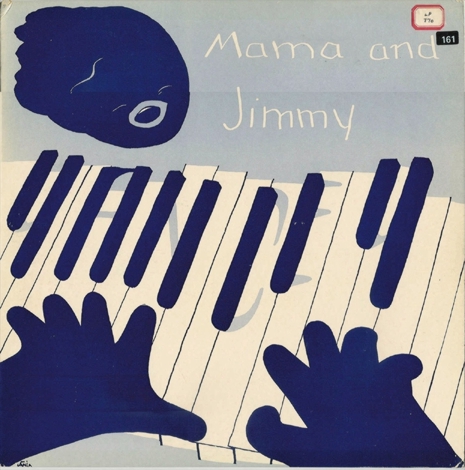
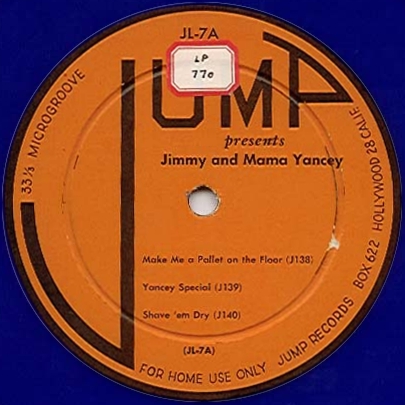
In 1953 Phil Featheringill, who still owed money to Ed Kocher and Clive Acker of Jump Records, allowed the company to dub his Jimmy Yancey and Cripple Clarence Lofton masters. (Jump affixed new matrix numbers to them; one of our goals is to provide a concordance with the original Session numbers.) Six of these items were used on a 10-inch LP, which was issued as Jump JL7, Jump Presents Jimmy and Mama Yancey; it was resplendently pressed on blue vinyl. The debt may have been for pressings, as Bishop and Jump shared a street address in 1946, or it could have stemmed from other transactions. In any event, Jump and The Turntable were still using the same PO Box in 1953. The date of the transaction comes from Clive Acker's reminiscences. In a letter to John Holley, dated July 1, 1978, Acker recalled:
Phil Featheringill (who made the Yanceys and the Punch Millers etc.) sold our records for a while out here. He was a nice guy and his story is long and interesting. He ran off with a gal who was a record salesperson and left owing us quite a bunch of money. He gave us the Yancey material when he left and the Cripple Clarence Lofton. We put out a Jump 10" LP of Yancey some time after that. It didn't sell much (none of our stuff did) but I still have the tapes.
Did any other Session material end up in the possession of Jump?
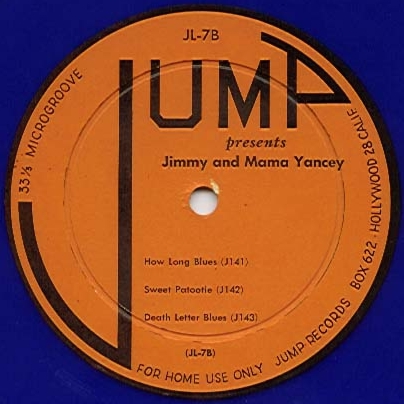
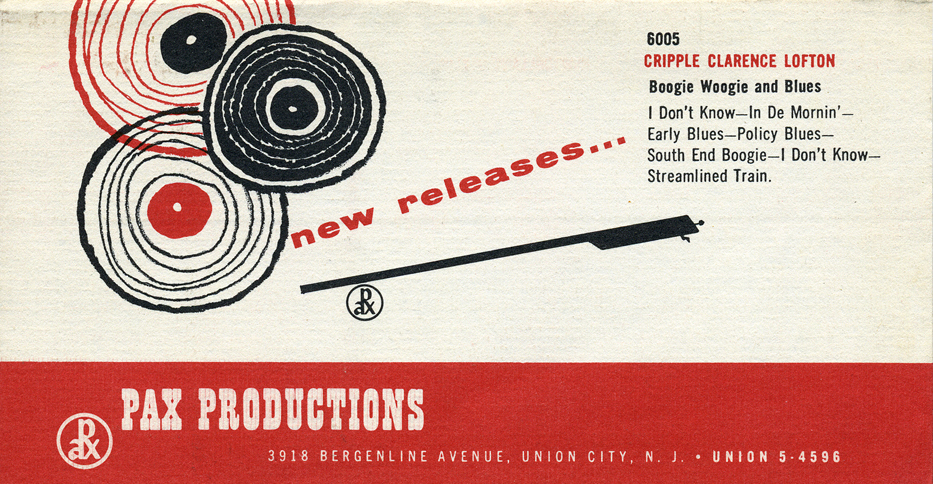
The next year someone concluded a bigger transaction. In "Session Catalog Is Sold to Pax" (May 5, 1954, p. 6), Down Beat announced that "Pax Productions, directed by Dante Bolletino and Al Zimet, have purchased the whole Session catalog, including many previously unissued masters." That same month, Pax issued a fairly ambitious catalog of jazz LPs. According to the special issue of the Matrixthat was devoted to Bolletino's labels (number 58, April 1965), Bolletino was a record store owner and entrepreneur based in the New York City area. His specialty was bootleg reissues of traditional jazz material, starting in 1948 for the spurious "British Rhythm Society" and continuing in 1950 with LPs on the frankly named Jolly Roger label. In January 1952, Louis Armstrong and Columbia Records sued Bolletino for copyright infringement. Bolletino quickly settled, destroying his stocks of bootleg records. However, he had begun recording material on his own in 1951 for his Paradox label.
Forced to regroup after being driven out of bootleg reissues, Bolletino opened the Pax label in June 1952. Its address was the Chimes Music Shop at 142 West 46th Street in New York City. After putting out just two known LPs, Pax became dormant. In 1954, Pax resumed activity from a location with much lower overhead, across the Hudson in Union City, New Jersey. Besides acquiring Session sides—according to Bob Koester, it was from Phil Featheringill's ex-wife, the first Evie, who provided acetates and not the masters he was expecting—Bolletino also made a deal to exchange masters with the French Vogue label. Pax put out all of its remaining LPs in 1954, to judge from the company's catalog from May of that year and an ad that Pax placed in Ramsey's 1954 Guide to Longplay Jazz Records. However, Pax was inclined to overoptimism, as we shall see..
The Pax LPs that contained Session material were all of the 10-inch variety, as was still the norm for jazz LPs in 1954. The 10-inch format lay somewhat awkwardly for the 12-inch Session masters, since there was room for just 3 per side (4 per side if they were all 10-inch masters).
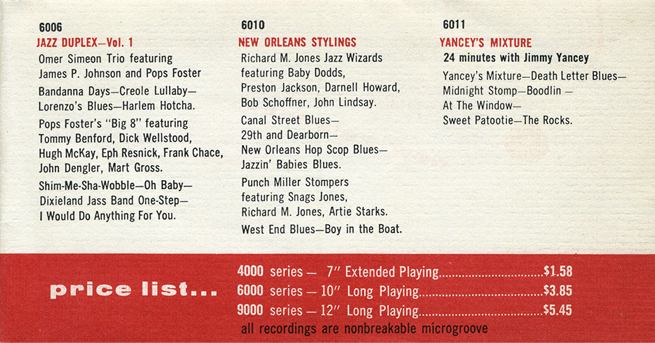
In all, Pax announced 6 1/2 Session-derived LPs:
In an early 1955 Record Changer (Vol. 14, no. 2), Bob Koester's Blue Note Record Shop in St. Louis offered all three Yancey LPs on Pax for sale. This of course is no guarantee that the store ever had all three of them in stock.
In fact, only three Session-based LPs were actually issued.
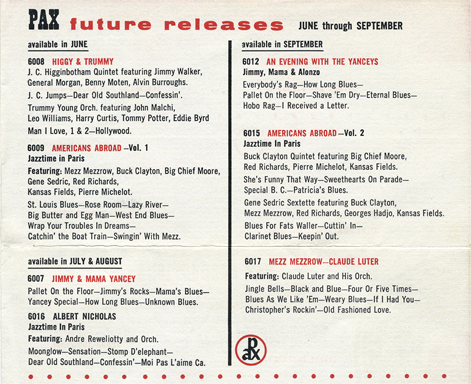
Other Pax LPs drawn from the French Vogue label featured such artists as Buck Clayton, Mezz Mezzrow, and Albert Nicholas. Material recorded by Bolletino's previous operations featured Omer Simeon, Pops Foster, George Lewis, the Eureka Brass Band and Wild Bill Davison. At one time or another, Pax also released 6001, 6004, 6006, 6009, plus its only 12-inch LP, on 9001; 6002, 6003, 6015, 6016, and 6017 were also among those that were supposed to happen but didn't.
Pax never announced releases of anything by Pete Brown, the Ben Webster/Sid Catlett Quartet, the Little Acorns/Chicago Jazzmen/Session Six, or John Levy and Jimmy Jones. No Jesse Young either. Which means that Dante Bolletino failed to take advantage of a fair amount of valuable material.
Pax quit issuing LPs at the end of 1954. Taking advantage of its deal with Bolletino, Vogue in France and Britain put out straight reissues of Pax LP 6005 in 1955 and Pax LP 6011 in early 1956. But in the first quarter of that same year Bolletino sold Pax to Jazztone. Jazztone, in its turn, put out two LPs of Session-derived material. The first of these was J-1224, which came out in the United States in March 1956 and in Europe somewhat later on (according to Geoffrey Wheeler's Jazz by Mail, 1999, p. 28 for the sale, and pp. 112-113 for J-1224). There was also J-1023, a 10-inch LP that appeared in Europe only (Wheeler, pp. 223, 225, 238-139); the issue date for J-1023 is not known with certainty but 1956 or 1957 is most likely. Jazztone J-1224 combined Pax LPs 6005 and 6011; J-1023 had the same lineup as the unissued Pax LP6012. Jazztone seems to have been interested only in the boogie-woogie piano; it almost certainly came into possession of other Session material when it bought Pax, but never did anything with it.
The classic source on Dante Bolletino's operations is Matrix 58 (April 1965), which was the joint work of Dan Mahony, Bert Whyatt, Frank Dutton, George Hulme, Derek Coller, Walter C. Allen, and Woody Backensto. The Pax listing (pp. 22-26) was done by George Hulme with help from Derek Coller.
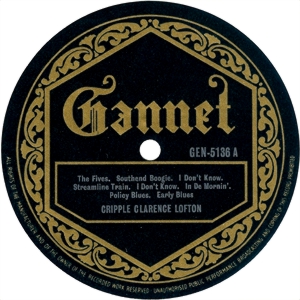
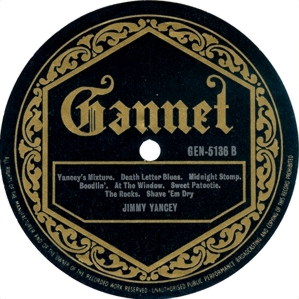
The Yancey and Lofton sides were reissued yet again starting in 1974 on John Holley's Gannet label, whose name and label design were deliberately evocative of the storied Gennett operation of the 1920s and 1930s. Many of the Gannet tracks were dubbed off Session 78s. Initially, Gannet labels actually used the same color scheme as Gennett 78s once had (gold on dark green). But this color scheme cost an arm and a leg to print, and so later labels were done in a much less expensive black on blue.
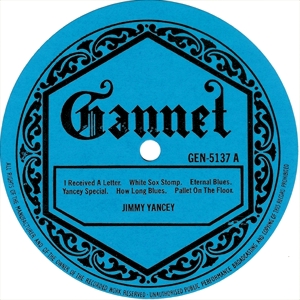
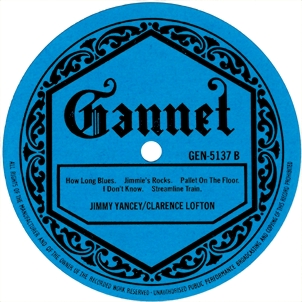
The first Gannet LP release, GEN 5136, was the first volume of the Yancey and Lofton material; it came out in 1974. 5136 was followed in due course by Volume 2 on GEN 5137 (also 1974) and Volume 3 on GEN 5138 (c. 1975; this last consisted of Jimmy and Alonzo Yancey sides). Other Gannet releases consisted of three volumes of Tiny Parham, six volumes of Ida Cox, a collection called Four O'Clock Blues, and single LPs of Jimmy O'Bryant and Jelly Roll Morton.
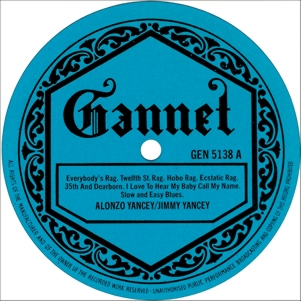
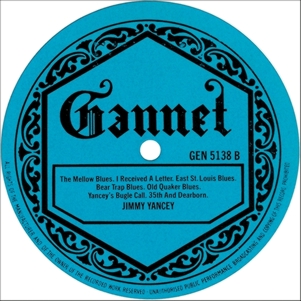
Later on Gannet would release 3 CDs, of which CJR 1002, New Orleans to Chicago: The Forties consisted in part of the Punch Miller and Richard M. Jones' sides for Session. The other CDs were a Chicago 1935 collection and Volume 1 of a complete State Street Ramblers set (the second volume came out on a different label).
The Danish Storyville label put out two LPs of Session material (again, Jimmy Yancey and Cripple Clarence Lofton) in the 1980s. These are of some discographical interest because while they included no previously unknown material, they did not merely recycle the Pax compilations. They were made with access to documentation that was not available when the Gannets were compiled, because they included matrix numbers for items that had never been released on 78s. Storyville had shown interest in Session material earlier (as we know from the test pressing of a Storyville 78 containing two such tracks), and that makes us wonder whether the company was ever in direct contact with Phil Featheringill or Dave Bell. However, Geoffrey Wheeler reports in his book Jazz by Mail (1999, p. 223) that Storyville also had the help of Allan Stephenson, who had previously been with Jazztone's operation in Denmark for 23 years.
A significant part of Session's mission was reissuing early jazz recordings; most of these came out in its first 4 months of operation. We have chosen to handle these reissues in an appendix since the masters were leased or purchased.
The reissues were 10-inch 78s, naturally the same format that the sides originally appeared in. Session 1 through 3 and 5 through 7 were released. 1 through 3 were described as already available in George Hoefer's Down Beat article (December 1, 1943, p. 13) that reported the opening of the store. Pressings for these were done by Gennett at the Starr Piano Company in Richmond, Indiana. Hoefer also mentioned Session 4 in this article, and plans to issue it were mentioned in a review of 1 through 3 in Piano Jazz, but there is no evidence that it ever got past the planning stage. 5 through 7 made their appearance in early March 1944.
The reissues appeared in two distinct waves. The first pressings carried "Reissue Session" on the label (copyright 1943 or 1944, Session Records Chicago). After Featheringill's move to Los Angeles in the middle of 1946, a second wave of pressings put just "Reissue" on the label and the copyright read "1946 W. P. Featheringill." The distinction between "Reissue Session" and "Reissue" is garbled in Lord's Jazz Discography. For Reissue Session 5, Lord lists both "Session 5" and "Reissue 5"; he makes no separate mention of the "Reissue" releases for any of the others except Reissue 8.
To further complicate matters, Featheringill did not put Reissue 8 into the lineup until after he shifted operations to Los Angeles. It was released toward the end of 1946, getting its first mention in a Records, Inc. ad in the Record Changer's December issue.
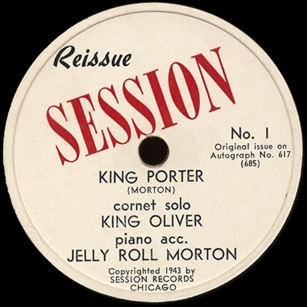
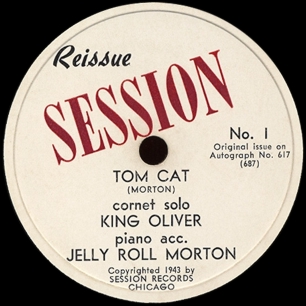
Joe "King" Oliver (cnt); Ferdinand Lamothe [aka Jelly Roll Morton] (p).
Marsh Laboratories, Chicago, December 1924
| 685; 100 685 or 100-685 | King Porter (Morton) | Autograph 617-A, Reissue Session 1, Reissue 1 | |
| 687; 101 687 or 101-687 B5 | Tom Cat (Morton) | Autograph 617-B, Reissue Session 1, Reissue 1 |
See http://www.doctorjazz.co.uk/page15.html#diskrec for up to date information about the recording session. At this time the Marsh Recording Laboratories were located in Suite 707 of the Lyon & Healy Building at 78 East Jackson Boulevard in Chicago.
Reissue Session 1 was announced in Down Beat on December 1, 1943 and reviewed on January 15, 1944, p. 16. Reissue 1 followed in 1946, after Featheringill started using The Bishop Presses. The session is covered in Tom Lord's Jazz Discography, Volume 16. According to George Avakian's review (see below), the extremely obscure original release on Autograph 617 was rediscovered around 1938. As Featheringill told Jake Trussell, Jr., in 1945, there may have been a 686 by King Oliver and Jelly Roll Morton, but if so it was already lost by then, and the title remains unknown. Lord neglects to list Reissue Session 1, which appears to have been the first 78 rpm reissue of these sides. In the LP era, this material was reissued on Riverside; it has subsequently appeared on many labels in both LP and CD formats.
Trussell, reviewing Sessions 1 through 3 in Piano Jazz no. 1, was not pleased with this 78. He thought it showed off Morton to some advantage, but... "The combination of worn surface, acoustic recording, and Oliver's tight tone all converage to make his soloing... thrilling—in the same sense as dragging a nail file through clenched teeth" (p. 19). (The recording was not acoustic. Autograph had been making primitivo-electrics for a couple of years by December 1924, but Trussell had no way of knowing that.)
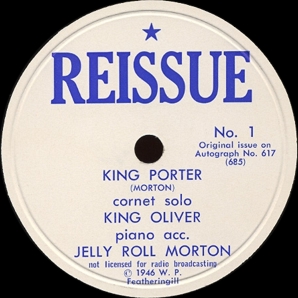
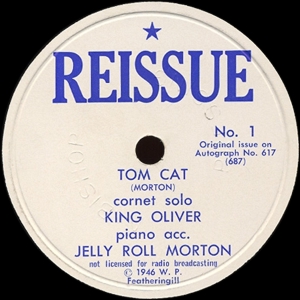
For its reissues Session assigned its own new matrix number, followed by the matrix number of the original recording. So 100 is the Session number and 685 is the matrix number originally assigned by Autograph. The matrix numbers without hyphens are from the Reissue Session release (copyright 1943) and those with hyphens are from the Reissue release (copyright 1946).
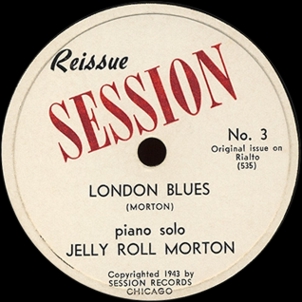
Jelly Roll Morton (p).
Marsh Laboratories, Chicago, April or May 1924
| 535; 105 535 or 105-535 B5 | London Blues (Morton) | Rialto [no number], Reissue Session 3, Reissue 3 |
The original, unnumbered release on the Rialto Music House label had a B side by Frank Collins singing "I Never Miss the Sunshine (When There's Moonshine Around)" and accompanying himself on the ukulele (according to http://www.mainspringpress.com/marsh.html, it carried matrix 531). This was, shall we say, not a reissue priority for jazz fans.
See http://www.doctorjazz.co.uk/page15.html#diskrec for up to date information about the recording session. At this time the Marsh Recording Laboratories were located in Suite 325 of the Kimball Building at 306 South Wabash Avenue in Chicago.
Reissue Session 3 was announced in Down Beat on December 1, 1943 and reviewed on January 15, 1944 (p. 16). In his review, George Hoefer, Jr., noted that "It is unfortunate that the copy from which the re-issue was dubbed was in rather poor condition" (p. 18). At the time "London Blues" was not listed in Delaunay's discography.
In 1945, Jake Trussell, Jr., declared that "London Blues is played jauntily, almost bouncily, exhibiting a co-ordination of kicks in both left and right hands that is seldom found nowadays" (Piano Jazz no. 1, p. 19).
The coupling chosen for Session 3 was a piano rag by Ezra Howlett Shelton (originally released on Autograph; see below).
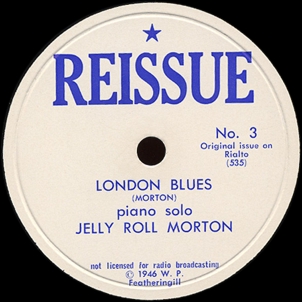
Reissue 3 followed in 1946; it has a distinctive label, a 1946 copyright date, matrix numbers stamped in the trail-off area, and Bishop's embossing on one side. The B5, perhaps a stamper number, is incised in a different region of the trail-off shellac.
There actually was a companion track to "London Blues" from this session—Jelly Roll Morton's piano solo on "Frog-I-More Rag" (534)—but it was never released on Rialto. "Frog-I-More" has been preserved only on account of a serendipitous find by John Steiner, who around 1940 bought a lot of 15 test pressings with blank labels and no matrix numbers at a Chicago junk shop. On one of them he recognized Morton's playing by ear; the composition was subsequently identified by William Russell and Roy Carew. The test pressing is now identified as the missing 534 because of the overall ambience, which resembles that of "London Blues" (both were primitivo-electric recordings). For a long time some people thought it might instead be an unissued "Frog-I-More" from The Roll's second session for Gennett, which was recorded acoustically. Steiner's find was not publicly announced till the April 1, 1944 issue of Down Beat, when George Hoefer Jr. spilled the beans in his "Hot Box" column, announcing that Steiner would soon release the side on S-D 103. Either Phil Featheringill did not know about Steiner's find in December 1943, or Steiner insisted on being the first to release it.
Our discographical listing derives from Tom Lord's Jazz Discography, Volume 15. Only 78-rpm issues are listed here; since appearing on Riverside LPs in the mid-1950s this track has been available in many forms.
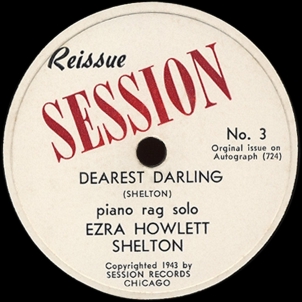
Ezra Howlett Shelton (p).
Marsh Laboratories, Chicago, c. February 1925
| 724; 104 724 or 104-724 | Dearest Darling (Shelton) | Autograph [no number], Reissue Session 3, Reissue 3 |
According to Jake Trussell, Jnr.'s 1945 review in Piano Jazz (no. 1, p. 19), neither the performer nor the session were listed in Delaunay's discography when the Session reissue came out. Shelton was a ragtime pianist who also wrote songs that were recorded by Lovie Austin and Papa Charlie Jackson.
Featheringill had an unnumbered Autograph 78 in his collection and dubbed this side from it. (As was often the custom at Autograph, the other side of the original 78 was by a different artist and lacked any jazz interest.) According to Trussell,
Featheringill...points out that on Session reissue no. 3 there is no dealer release number for the Rialto, nor for the Shelton solo. This is the rule rather than the exception on Autograph and Rialto records. It actually doesn't mean anything.
Trussell pronounced the Shelton side the work of a "truly great ragtime pianist"; he was particularly intrigued by a twittering right-hand lick, lasting about a bar, that Shelton was careful to use only once on the piece.
This session is covered in Tom Lord's Jazz Discography, Vol. 20. According to Lord, Shelton made just two more sides, at a session for Victor in Chicago in 1928. Neither of these was issued on 78, but "Flapper's Stomp" appeared (for the first time?) on Document BDCD-6045, released in 1993, and "Gonna Quit That Man and How!" came out in 1998 on Document DOCD-5625.
The matrix series used by Rialto and Autograph derives from Marsh Laboratories, in the acoustic and early electrical eras a major recording studio in Chicago. The Autograph labels claimed an electrical recording. Marsh was indeed using some kind of microphone by the end of 1922, though the sonics on the outfit's early electrical recordings were often poor enough to occasion skepticism from listeners (see http://www.mainspringpress.com/marsh_electric.html).
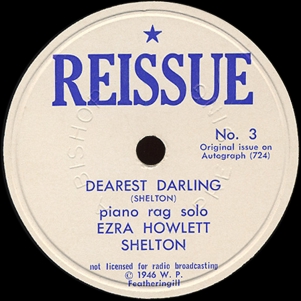
The later pressing on Reissue 3 has the distinctive Reissue label, a 1946 copyright date, the Bishop embossing on one side, and stamped matrix numbers.
The Down Beat review describes "Dearest Darling" as a ragtime piano solo with no jazz content. The only known reissue is on Document DOCD-5596, a CD released in 1998.
Lee Collins (cnt); unidentified (cnt -1); Roy Palmer (tb); "Balls" Ball (cl); Alex Poole (as); Jelly Roll Morton (p).
Marsh Laboratories, Chicago, c. September 1924
| 635; 102 635 or 102-635 B5 | Fish Tail Blues (Morton-Collins) | Autograph 606-A, Reissue Session 2, Reissue 2 | |
| 636; 103 636 or 103-636 | High Society ("Palmer") | Autograph 606-B, Reissue Session 2, Reissue 2 | |
| 638 | Weary Blues (Matthews)-1 | Autograph 607-A, Reissue Session 4 [?] | |
| 639 | Tiger Rag (LaRocca) | Autograph 607-B, Reissue Session 4 [?] |
The original release, on Autograph, took place in late 1924 or early 1925. Autograph was owned by Orlando Marsh, who also ran the Marsh Recording Laboratories (see Alex van der Tuuk's discography at http://www.mainspringpress.com/marsh.html). When Featheringill decided to reissue this material, none of it was listed in Delaunay's discography.
See http://www.doctorjazz.co.uk/page15.html#diskrec for up to date information about the recording session. At this time the Marsh Recording Laboratories were located in Suite 707 of the Lyon & Healy Building at 78 East Jackson Boulevard in Chicago. According to this discography, a second cornet or trumpet player is present on two chorsues of "Weary Blues" but not elsewhere on the session.
(Reissue) Session 2 and 4 were announced in Down Beat on December 1, 1943. Session 2 was reviewed on January 15, 1944, p. 16, with a notation that Session 4 hadn't been released yet.
Reissue Session 2 was reviewed (along with Session 1 and 3) by Jake Trussell, Jr., in Piano Jazz no. 1 (London, 1945). Trussell saw the main value of Session 2 as historical. The original recording was made "in the days when a recorded jazz band sounded like the tossing of sleigh bells into a concrete mixer. Jelly Roll in 1924 just couldn't have sounded as bad as these Kings of Jazz sides would lead you to believe." Collins and Palmer get conditional approval from Trussell, but Ball "limps through the traditional clarinet chorus on High Society" (p. 19). Poole's identity was not known to reviewers at the time.
The Reissue 2 version, which was pressed by Bishop and carries a Bishop stamper number on one side, appeared in 1946 after Featheringill had moved his operations to the West Coast.
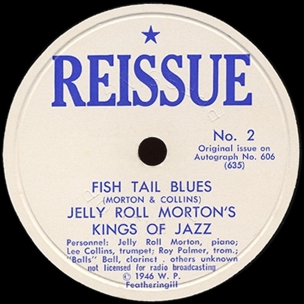
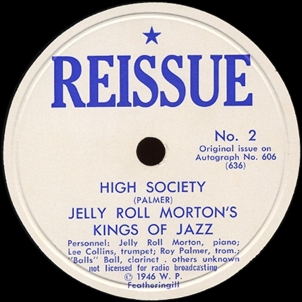
These four sides are covered in Tom Lord's Jazz Discography Volume 15. According to Lord, Reissue Session 4 (Lord leaves off the "Reissue" from the label) never did happen. Presumably this means there wasn't a Reissue 4 in 1946 either. Since we don't know what the Session matrix numbers were supposed to be , we have supplied only the original matrix numbers for "Weary Blues" and "Tiger Rag." Collectors, what say you?
In the LP and CD eras, the material from this session has been available, initially from Riverside, and subsequently on multiple reissues in the Fantasy/Prestige/Milestone family as well as European products with varying degrees of legitimacy.
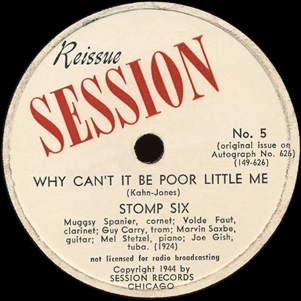
(Reissue) Session 5 through 7 were announced in Down Beat on March 15, 1944 (George Hoefer, Jr.'s "Hot Box" column, p. 12).
Muggsy Spanier (cnt); Guy Carey (tbn); Volly de Faut (cl); Mel Stitzel (p); Joe Gish (tu); Ben Pollack (d).
Marsh Laboratories, Chicago, c. July 1925
| 828; 149-626 | Why Can't It Be Poor Little Me (Kahn-Jones) | Autograph 626, Reissue Session 5, Reissue 5 | |
| 829; 148-626 | Everybody Loves My Baby | Autograph 626, Reissue Session 5, Reissue 5 |
Our information about this session is proximately drawn from Lord's Jazz Discography Volume 12. Lord notes that many reissues show the correct title, "Why Couldn't It Be Poor Little Me?" instead of the title as rendered by Autograph. Session follows the original title. Lord misprints the release number for matrix 828 as Autograph "828" instead of 626. Apparently Session did not have the original Autograph matrix numbers available, so after the Session prefix the Autograph issue number was appended instead.
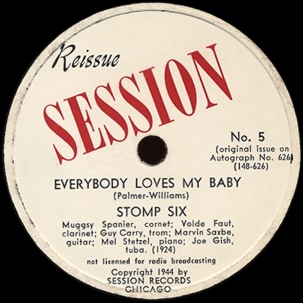
Reissue Session 5 was the first reissue of these titles; it was announced in Down Beat on March 15, 1944. In his column "The Hot Box" (p. 12) George Hoefer Jr. tells a dramatic story of Muggsy Spanier walking into the Session Record Shop while a copy of Autograph 626 was on the turntable. Spanier promptly gave Featheringill the date and personnel for the recording (though he added Marvin Saxbe on guitar, couldn't remember Joe Gish's last name, and put the date in 1924).
Lord mentions Reissue 5. We have not seen a copy, but if there was one, it came out with the second wave of pressings in 1946. Confirmation would be good.
Starting in the mid-1950s these two sides have appeared on Riverside LPs; there have been many other LP issues of varying legitimacy, from such sources as London, Swaggie, Fountain/Retrieval, Joker, and BYG, as well as a couple of CD-era reissues.
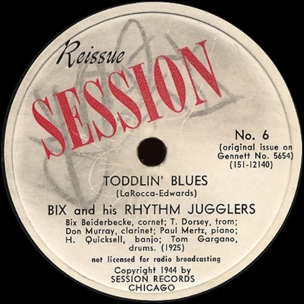
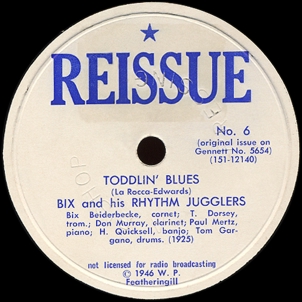
Leon "Bix" Beiderbecke (cnt); Tommy Dorsey (tb); Don Murray (cl); Paul Mertz (p); Howdy Quicksell (bjo on -1 only); Tom Gargano (d).
Gennett Studios, Richmond, Indiana, January 26, 1925
| 12140; 151-12140 | Toddlin' Blues (LaRocca-Edwards) | Gennett 5654, Reissue Session 6, Reissue 6 | |
| 12141; 150-12141 | Davenport Blues (Beiderbecke) | Gennet 5654, Reissue Session 6, Reissue 6 |
Our session information is drawn from Tom Lord's Jazz Discography, Vol. 2. Two more sides were recorded at this session but were never released and are long since lost. Lord does not mention (Reissue) Session 6, the first reissue of this material; Session 6 was announced in Down Beat on March 15, 1944.
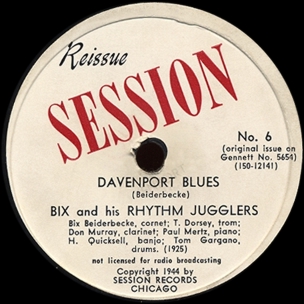
Reissue 6 (also not mentioned in Lord) followed in 1946. Starting in the mid-1950s, these sides were reissued on LP by Riverside and have subsequently appeared on many different LP and CD compilations.
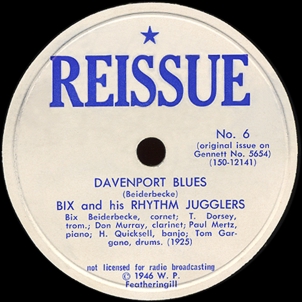
The 1946 issue uses the distinct white Reissue label with blue type (embossed with "A Bishop Pressing" on one side), shows a 1946 copyright date, and has stamped matrix numbers.
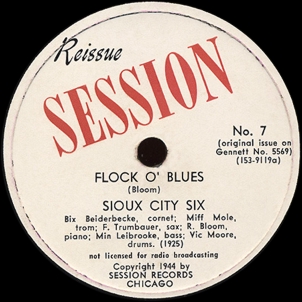
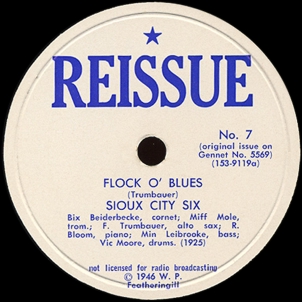
Bix Beiderbecke (cnt); Miff Mole (tb); Frankie Trumbauer (C melody sax); Rube Bloom (p); Min Leibrook (tu); Vic Moore (d).
New York City, October 10, 1924
| 9119-A; 153-9119a or 153-9119-A | Flock o' Blues (Bloom) | Gennett 5569, Reissue Session 7, Session 7 | |
| 9120-C; 152-9120c or 152-9120-C | I'm Glad (Trumbauer) | Gennett 5569, Reissue Session 7, Session 7 |
This session can be found in Tom Lord's Jazz Discography, Vol. 20. On this occasion Lord lists the Session, which was the first reissue of these two tracks. Since appearing on a Riverside LP in the mid-1950s, these two sides have been reissued on many LP and CD Bix compilations.
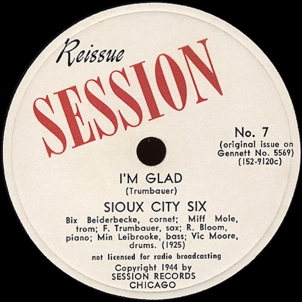
(Reissue) Session 7 was announced in Down Beat on March 15, 1944. Reissue 7 followed in 1946. Reissue Session 7 showed a 1944 copyright date on its white labels; matrix numbers were incised in the shellac. Reissue 7, with a different white label that has the Bishop embossing on one side, shows a 1946 copyright date and the matrix numbers are stamped.
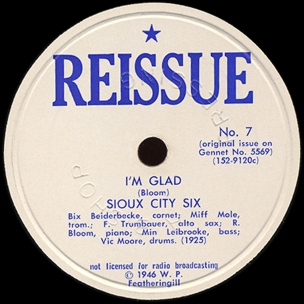
The Session labels gave the recording date as 1925.
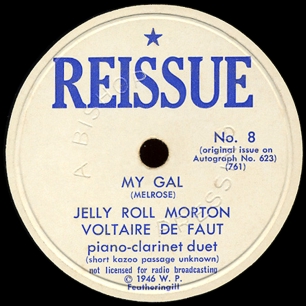
Jelly Roll Morton (p); Volly de Faut (cl); W. E. Burton (kazoo -1)
Marsh Laboratories, Chicago, May 1925
| 791; 155-761 DP | My Gal (Melrose) -1 | Autograph 623-B, Reissue 8 | |
| 792; 154-762 DP | Wolverine Blues (Morton) | Autograph 623-A, Reissue 8 |
See http://www.doctorjazz.co.uk/page15.html#diskrec for up to date information about the recording session. At this time the Marsh Recording Laboratories were located in Suite 707 of the Lyon & Healy Building at 78 East Jackson Boulevard in Chicago.
Reissue 8, first advertised in the Record Changer in December 1946, consisted of Morton's last two sides for Autograph, as originally issued on Autograph 623. The Autograph matrix numbers were 791 and 792, misread by Session as 761 and 762. The Reissue prefixes, 154 and 155, follow those given to Reissue Session 5 through 7 but also inadvertently duplicate the first two matrix numbers from the Richard M. Jones session. The Reissue matrix numbers are incised in the trail-off area. There is a P in a D, for Dike-Polzin, which was now doing the metal parts for Bishop, below the actual matrix number.
On the Reissue 8 label, the kazoo player on "My Gal" is left unidentified.
Since appearing on a Riverside LP in the mid-1950s, these two sides have been reissued on many LP and CD Jelly Roll Morton compilations. Lord's Jazz Discography mentions Reissue 8.
In the October 1947 issue of the Record Changer (p. 33), Records, Consolidated put up records from Featheringill's own collection for sale. Easily picked out of the list are the originals (most of them extremely rare) that he had dubbed for these reissues. Auctioning off the originals was a decisive way of getting out of the reissue business. However, Phil Featheringill retained the dubs he had made.
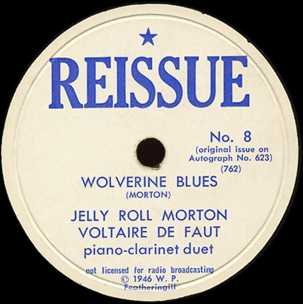
For the Fall and December 1943 sessions, we benefited from the listings in R. M. W. Dixon, J. Godrich, and H. W. Rye, Blues and Gospel Records 1890-1943, 4th edn., Oxford: Oxford University Press, 1997. Görgen Antonsson's added listings of LP releases were also helpful, although they contain some errors (http://sunsite.kth.se/feastlib/mrf/yinyue/pw/LOFCLA.HTM, http://sunsite.kth.se/feastlib/mrf/yinyue/pw/YANALO.HTM, and http://sunsite.kth.se/feastlib/mrf/yinyue/pw/YANJIM.HTM). There are many errors in previous listings of the LP reissues, particularly of the heavily trafficked Jimmy Yancey and Cripple Clarence Lofton sides; wherever possible, we have worked directly from LPs in the collections of John Holley and Konrad Nowakowski.
The ultimate origin of much of our information on the Session and Pax material is a series of articles in the Matrix. John Holley and George Hulme published a Session listing in Matrix 70; Hulme published the Pax listing in Matrix 58; and Holley was responsible for the Yancey discography in Matrix 95. This last item drew, in turn, from Walter C. Allen's earlier Yancey discography in Record Research Vol. 2 No. 1, issue 7.
We are thankful to Franz Hoffmann for spotting an error on a previous version of this very long and involved page.